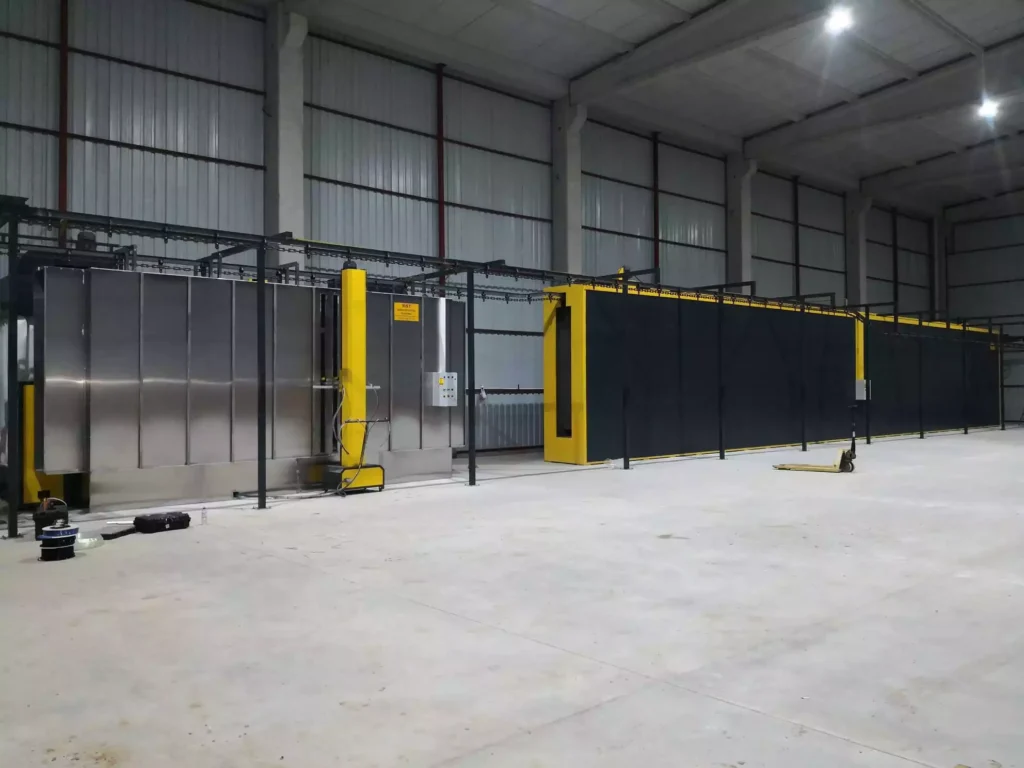
The manufacturing process for powder coating equipment can vary depending on the specific type of equipment being manufactured. However, there are some general steps that are common to all powder coating equipment manufacturing processes.
Step 1: Design
The first step in the manufacturing process is to design the powder coating equipment. This involves creating detailed drawings and specifications for the equipment. The design process typically takes into account factors such as the type of powder coating to be applied, the desired finish, and the production volume.
Step 2: Material procurement
Once the design is complete, the next step is to procure the necessary materials. This includes both raw materials, such as steel and aluminum, and pre-fabricated components, such as powder coating guns and ovens.
Step 3: Fabrication
The fabrication process involves cutting, forming, and welding the raw materials into the powder coating equipment components. This is a skilled process that requires specialized equipment and training.
Step 4: Assembly
Once the components have been fabricated, they are assembled into the complete powder coating equipment system. This process typically involves connecting the components together, wiring the electrical system, and installing the powder coating gun and oven.
Step 5: Testing
Once the powder coating equipment has been assembled, it is tested to ensure that it is working properly. This involves testing the powder coating gun, the oven, and the conveyor system.
Step 6: Packaging and shipping
Once the powder coating equipment has been tested and approved, it is packaged and shipped to the customer.
Quality control
Quality control is an important part of the powder coating equipment manufacturing process. Quality control inspectors typically inspect the equipment at various stages of the manufacturing process to ensure that it meets the customer’s specifications.
Safety
Safety is another important consideration in the powder coating equipment manufacturing process. Manufacturers typically have a number of safety measures in place to protect workers from accidents and injuries. These safety measures may include things like machine guards, lockout/tagout procedures, and safety training.
Trends in powder coating equipment manufacturing
One of the trends in powder coating equipment manufacturing is the increasing use of automation. Automation can help to improve the efficiency and quality of the powder coating process. For example, automated powder coating guns can help to ensure a more even application of powder coating.
Another trend in powder coating equipment manufacturing is the development of more environmentally friendly equipment. For example, some manufacturers are now offering powder coating ovens that use less energy and produce fewer emissions.
Conclusion
The manufacturing of powder coating equipment is a complex process that requires a variety of skills and expertise. Manufacturers must carefully design, fabricate, assemble, and test their equipment in order to produce high-quality powder coating equipment that meets the needs of their customers.
As one of the powder coating equipment manufacturers, we manufacture all the necessary equipment required to powder coat your parts such as powder coating oven, spray booth, spray gun, drying oven, and conveyor lines
There are plenty of powder coating equipment manufacturers in the world, some of which are fine in quality but very high in price, some are fine in price but very low in quality and some are both high in price and low in quality. As an intelligent alternative, we offer powder coating equipment for a very find price range with very high quality.
The quality of the powder coating equipment can be understood by checking the powder-coated metal paint. The powder-coated metal finish shows the quality of the powder-coating powder and also the equipment. The cheap powder coat paint can also affect the quality of the coating as well as the cheap powder coating machine itself but anyway the waves on the parts will unclue the quality of the coating equipment.
Powder Coating Equipment Manufacturers
The powder coating for guns is a plastic-based chemical substance, produced in different colors and 25 kg batch packages. There are some European and American powder coating powder manufacturers which are accepted as the manufacturers of the best powder for powder coating.
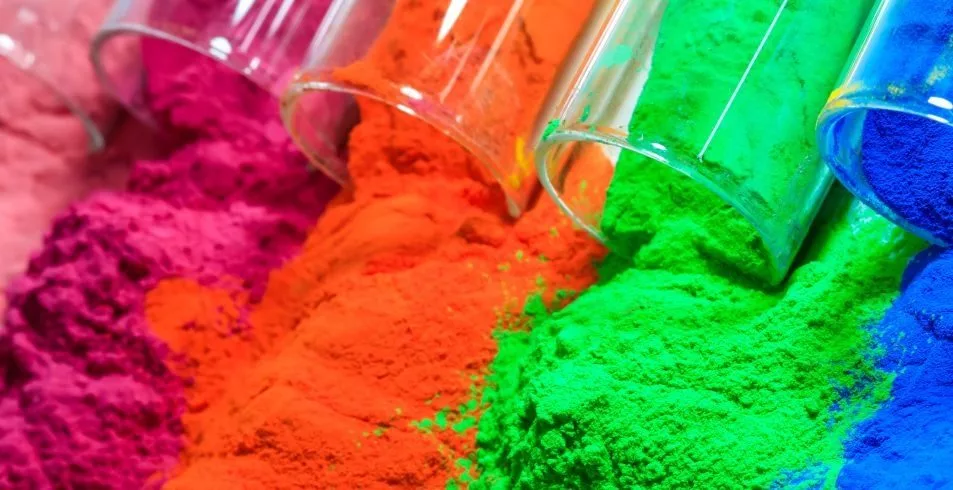
The plastic coating material also called as the powder coat finish spray paint is used to coat the metal part and melt in a curing oven. This process is called the metal powder coating process. In order to have a successful powder coating, The operator needs to have a high-quality powder coating gun to spray paint on powder-coated metal.
Industrial Powder Coating Equipment
Industrial powder coating equipment is a system of tools and machines that is used to apply powder coating to a variety of surfaces in a high-volume production environment. Powder coating is a durable and decorative finish that is often used on metal surfaces, such as automotive parts, appliance components, and electronic enclosures.
Industrial powder coating equipment typically includes the following components:
- Powder coating gun: The powder coating gun is used to spray powder coating onto the surface of the part being coated. Industrial powder coating guns are typically equipped with high-voltage electrodes to attract the powder coating particles to the part.
- Powder coating booth: The powder coating booth is a ventilated enclosure that contains the powder coating gun and the part being coated. The booth helps to collect overspray powder coating and prevent it from contaminating the environment.
- Powder coating oven: The powder coating oven is used to cure the powder coating and make it durable. Industrial powder coating ovens are typically conveyorized, meaning that the parts are transported through the oven on a conveyor belt.
- Control system: The control system controls the operation of the powder coating gun, the powder coating booth, and the powder coating oven. The control system also ensures that the parts are coated properly and that the powder coating process is efficient.
In addition to these basic components, industrial powder coating equipment may also include a number of other components, such as:
- Pretreatment system: The pretreatment system cleans and prepares the surface of the part for powder coating. This is important for ensuring a good adhesion between the powder coating and the part.
- Powder coating reclaimer: The powder coating reclaimer recovers overspray powder coating and recycles it back into the powder coating process. This helps to reduce costs and waste.
- Conveyor belt: The conveyor belt transports the parts through the powder coating booth, the powder coating oven, and the other components of the powder coating system.
- Benefits of using industrial powder coating equipment
- Industrial powder coating equipment offers a number of benefits, including:
- High efficiency: Industrial powder coating equipment can coat parts very quickly, which can help to improve productivity in high-volume production environments.
- Uniform application: Industrial powder coating guns are designed to apply powder coating evenly to the surface of the part, which can help to improve the quality of the finish.
- Durability: Powder coating is a very durable finish that can withstand a variety of environmental conditions.
- Environmental benefits: Powder coating is an environmentally friendly process that produces very few emissions.
- Applications of industrial powder coating equipment
- Industrial powder coating equipment is used in a wide variety of industries, including:
- Automotive: Industrial powder coating equipment is used to coat automotive parts, such as wheels, bumpers, and chassis components.
- Appliance: Industrial powder coating equipment is used to coat appliance components, such as washing machine drums and refrigerator doors.
- Electronics: Industrial powder coating equipment is used to coat electronic components, such as circuit boards and enclosures.
- General manufacturing: Industrial powder coating equipment is used to coat a wide variety of parts in the general manufacturing industry.
- Conclusion
- Industrial powder coating equipment is a valuable tool for businesses that need to coat parts quickly, efficiently, and with high quality. By choosing the right industrial powder coating equipment and using it properly, businesses can improve productivity, quality, and environmental impact.
Regarding the industrial powder coating equipment, we can list them as:
- Complete Automatic Powder Coating System
- Manual Powder Coating Equipment
- Semi Automatic Powder Coating Line
Complete Automatic Powder Coating System
In a complete automatic powder coating system, we will see a surface pretreatment part, in the beginning, to clean the parts from oil, rust, and dust. Here in order to have a near-perfect surface pretreatment, companies use chemical substances such as alkaline or acidic cleaners.
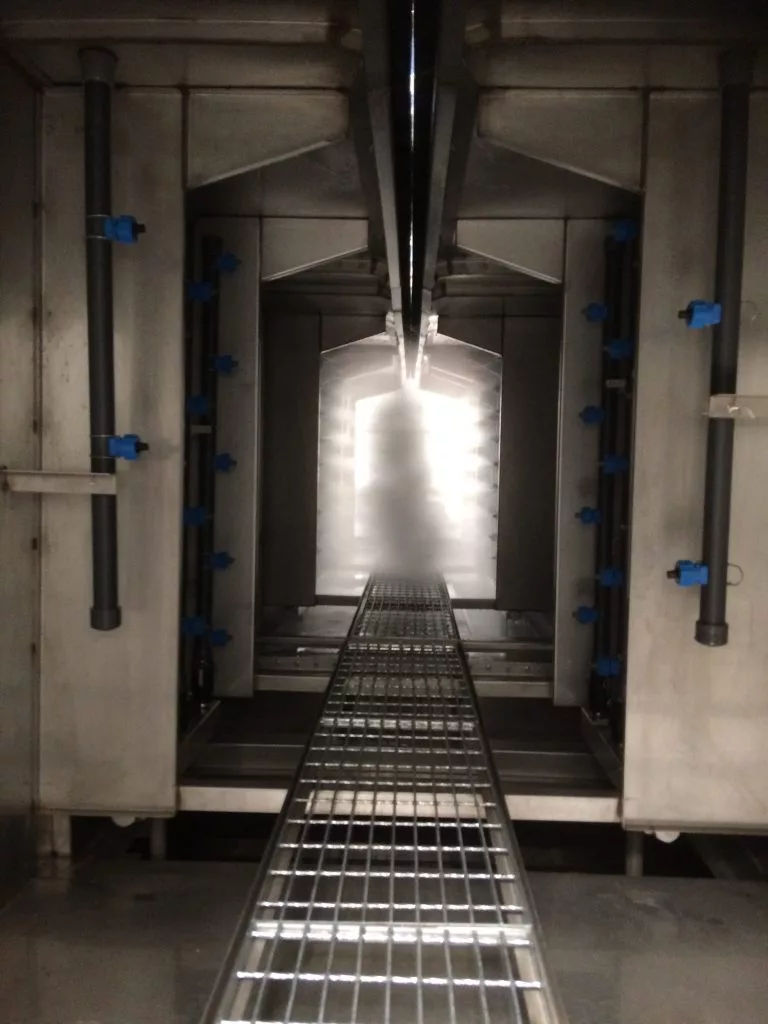
The surface pretreatment is a mechanical device, having spray nozzles surrounding the part to be cleaned. These pressure washer nozzles are used to spray water on parts under high pressure. The spray nozzle types depend on the aim of the spraying geometry. The spraying angle is determined by the part dimensions and part dirtiness.
High-Pressure Water Jet Nozzles
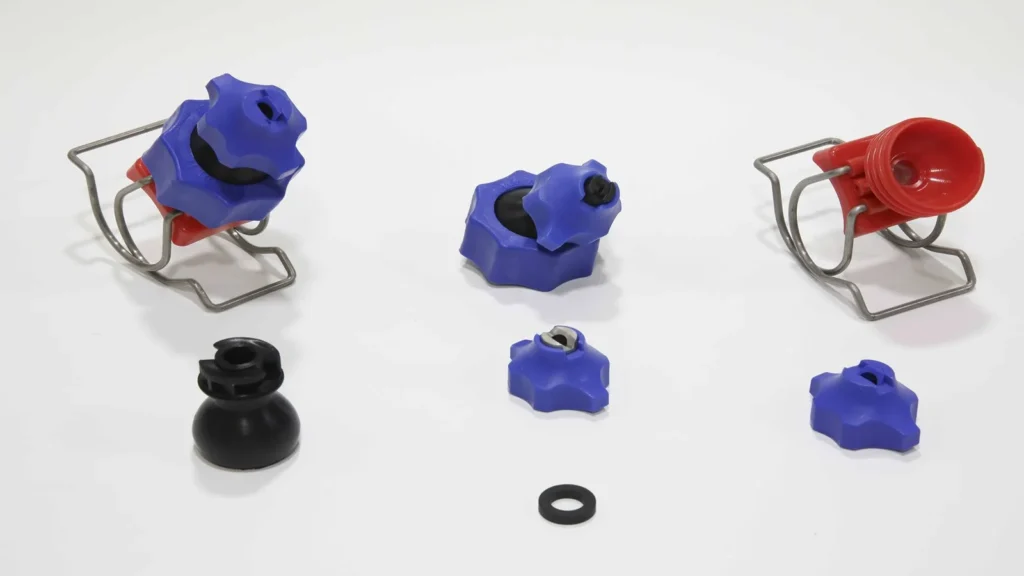
High-pressure water jet nozzles are a versatile and effective tool for surface pretreatment, offering a range of benefits over traditional methods such as sandblasting and chemical etching. They are particularly well-suited for applications requiring precision, efficiency, and environmental friendliness.
Advantages of High-Pressure Water Jet Nozzles for Surface Pretreatment
- Precision Cleaning: High-pressure water jets can precisely target and remove contaminants from specific areas of the workpiece, minimizing damage to the underlying substrate.
- Efficient Cleaning: The high velocity of the water jet effectively removes stubborn contaminants, including rust, paint, and grease, reducing cleaning time and labor costs.
- Environmentally Friendly: High-pressure water jet nozzles eliminate the need for hazardous solvents or abrasives, promoting a more sustainable and environmentally friendly surface pretreatment process.
- Versatile Applications: High-pressure water jet nozzles can be used on a wide range of materials, including metals, plastics, glass, and composites.
- Cost-Effective: High-pressure water jet nozzles are relatively inexpensive to operate and maintain compared to other surface pretreatment methods.
Types of High-Pressure Water Jet Nozzles for Surface Pretreatment
- Flat Fan Nozzles: These nozzles produce a flat, fan-shaped spray pattern, ideal for cleaning large, flat surfaces with consistent pressure distribution.
- Rotary Nozzles: Rotary nozzles generate a rotating spray pattern, providing a more aggressive cleaning action for removing stubborn contaminants from complex shapes.
- Pencil Nozzles: Pencil nozzles produce a narrow, focused stream of water, suitable for precision cleaning of intricate areas or removing deeply embedded contaminants.
- Multiple-Stream Nozzles: Multiple-stream nozzles emit multiple streams of water simultaneously, providing a broader cleaning coverage and increased cleaning efficiency.
Factors to Consider When Selecting High-Pressure Water Jet Nozzles
- Workpiece Material: Choose nozzles compatible with the material being cleaned to avoid damaging the substrate.
- Contaminant Type: Select nozzles based on the type and severity of contaminants to be removed.
- Workpiece Shape and Size: Consider the nozzle’s spray pattern and coverage area to match the workpiece’s geometry and size.
- Flow Rate and Pressure Requirements: Ensure the nozzle can handle the required flow rate and pressure for effective cleaning.
- Environmental Regulations: Choose nozzles that comply with local environmental regulations regarding wastewater disposal.
Applications of High-Pressure Water Jet Nozzles for Surface Pretreatment
- Rust Removal: Removing rust from steel surfaces prior to painting or coating.
- Paint Stripping: Stripping old paint layers from various substrates, including metals, wood, and concrete.
- Grease and Oil Removal: Eliminating grease and oil deposits from machinery, automotive parts, and industrial equipment.
- Mold and Mildew Removal: Cleaning mold and mildew from surfaces in food processing facilities, bathrooms, and other moisture-prone areas.
- Surface Roughening: Enhancing surface adhesion for applying coatings or adhesives.
- Surface Preparation for Welding: Preparing surfaces for welding to ensure proper weld penetration and adhesion.
- Concrete Surface Cleaning: Cleaning concrete surfaces to remove graffiti, stains, and surface imperfections.
- Pipeline Cleaning: Removing debris, scale, and corrosion from pipelines and piping systems.
Conclusion
High-pressure water jet nozzles have become an essential tool for surface pretreatment, offering a combination of precision, efficiency, and environmental friendliness. By selecting the appropriate nozzle type and considering the workpiece material, contaminant type, and environmental regulations, industries can achieve effective surface pretreatment and enhance the performance and longevity of their products or equipment.
Automatic Powder Coating Lines
What is an automatic or automated powder coating system? There are some different ways to have a part powder coated. If the capacity is low, you can powder coat it manually with a gun, or booth, and then put the painted part into the oven. If the capacity gets bigger, you may require more extensive equipment and more capacity to have the same amount of parts to be painted in the same time period.
A bigger line may be a semi-automatic line where the movement of the parts is carried out by steel bars. These bars look like rails and the trolleys move within these rails inside and outside the booth and oven. This way the capacity can be a few times higher.
But in some cases, these semi-automatic lines can also not be sufficient and you need a more swift line to have a greater amount of parts to be coated in the same time period. This 3rd option is called the “Automatic powder coating system”.
Parts of an automatic powder coating lines
An automatic powder coating system can have the following parts:
- Surface pretreatment
- Drying
- Powder Coating
- Powder Curing
- Unloading and Loading new parts
Surface Pretreatment
Phosphating
Pretreatment- The preparation of a part prior to the application of a coating in order to improve adhesion & corrosion resistance.
Phosphating is a surface treatment process by which the virgin steel surface is converted to metallic phosphate & is widely used for preparing the metal surfaces before painting. (Thickness lies between 3 to 50 microns)
Phosphate coatings are produced by the chemical reaction of base metal with an aqueous solution of phosphoric acid and phosphates (Ions of Bivalent metals…Zn +2 , Mn +2 , Fe +2 ). Such coatings do not offer complete resistance to the atmosphere & principally used as an adherent base/primer coat for paints.
The Mechanism of the Phosphating
The free phosphoric acid in phosphating solution reacts with the Iron surface undergoing treatment in the following manner:
– Fe + 2H 3 PO 4 > Fe (H 2 PO 4 ) 2 + H 2
- The conventional seven-tank Hot Zinc Phosphating system is used.
- The following are the different steps involved in the process:
- Alkali degreasing
- Cold swilling
- De – rusting
- Cold swilling
- Hot phosphating
- Cold swilling
- Sealing/Passivation
Drying Oven of Automatic Powder Coating Lines
The dipping type surface pretreatment process requires a fast drying operation after the chemical process to have good paint quality. Materials dry within 10-12 minutes by drying oven. Circulation canals and airflow is designed to have a fast, regular and economic drying operation.
The drying degree should not be over 125°C to save the phosphate covered on the material. The ideal temperature is between 100-110°C. The drying oven has been designed and produced by EMS Powder Coating Equipment. so as to increase the temperature to 120°C within 35-40 minutes.

Technical Specifications of a Drying Oven
- Heating type: With thermocouple, closed air circulation, indirect heating
- Heating Capacity: Calculated according to the capacity of the project
- Circulation fans : 3 Pieces x 4 kW Ø560
- Burner: Uret (Made in Turkey)
- Insulation: 150 mm.
- Air Curtains : 2 units x 3 kW = 6 kW
- Exhaust fan : 0,55 kW
Oven Body
The outside surface of the oven’s body is galvanized (powder painted); the inner side has been made of galvanized sheet metal, and have isolated with 150 mm Rockwool and 100 mm Glasswool, compressed into 150 mm of isolation. Panels of sandwich-shaped ovens are attached to each other with high heat resistant silicone
The Heating Unit of the Drying Oven
The heating unit’s capacity makes it able to increase the heat of the oven to 120 ºC. The firing room of the heat exchanger is made of AISI 310S quality stainless steel and its pipe sheaves are made of normalized caldron pipe. The body of the heating unit is isolated with150 mm Rockwool. Hot dry air prepared in the heating unit will be homogeneously distributed inside the oven with help of adjustable air canals which are made of galvanized sheet metal.

Stainless Steel Automatic Powder Coating Booth
The automatic powder coating booth is designed for automatic lines, where there is a conveyorized line carrying the parts into the booth. The booth has openings from each side for the reciprocators and can also have painter posts where the painter can stand with his manual powder coating gun and correct the unpainted parts (if there are any – this depends on the geometry difficulty) for better finishing.
Automatic powder coating booths are equipped with cyclons and an after filter group, dedicated to filtering the powder particles flying through the Cylon into the exhaust box.
Cyclon is cone-shaped equipment, where the air with flying powder particles is flying in from the upside part and circulates inside and this circulation of air helps the heavy particles (such as powder particles) to settle and sit down the cyclone and gets transferred to the powder coating booth back by a powder injector.
This powder coating injector works with the venturi principle and operates with compressed air.
Plastic (PVC) Quick color change powder coating booth
The plastic automatic powder coating booth operates with 2 robot reciprocators on both sides, whose working height can be determined according to the height of the workpieces.
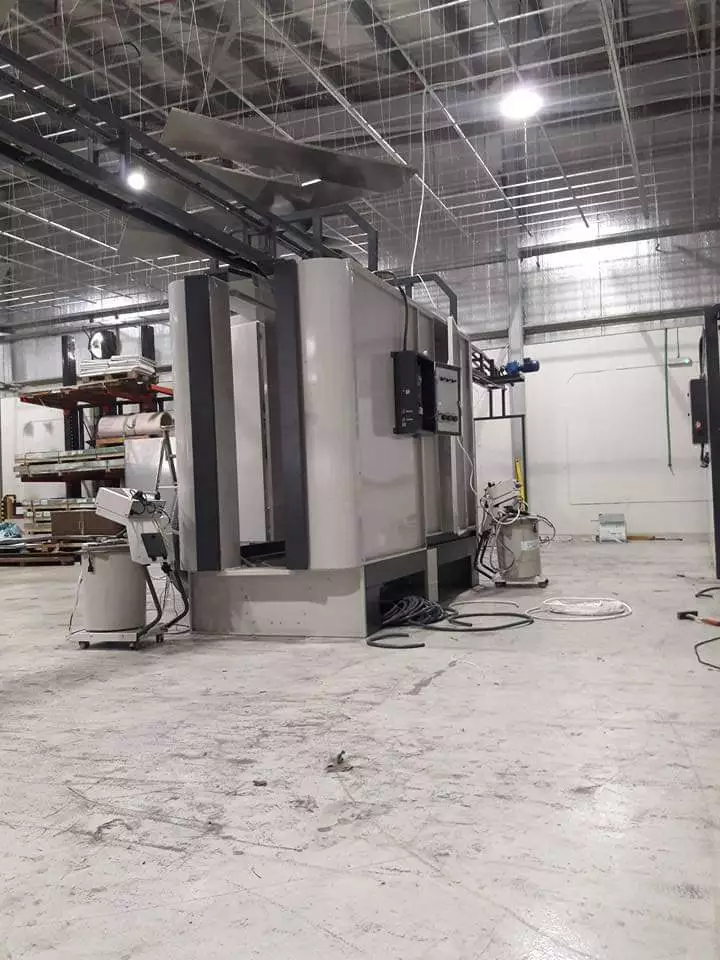
Automatic Powder Coating Booths can be made from galvanized sheet, stainless steel and also PVC for fast cleaning options.
The air inside is calculated according to the space required inside of the booth and the circulating air inside the booth also determines the cyclone capacity
During the electrostatic powder painting process, approximately 70% of the paint sticks on the part, depending on the structure of the part. For the paint which does not get stuck on the part to not get spread in the environment, a “Powder Paint Application Booth” is required. Dimensions of the powder paint application cabinet, capacity, pressure of the sucking fan, filter count, using suitable filters, etc. is extremely important.
To create a suitable air velocity within the cabinet and overcome the resistance of the filters during the painting process, a fan with suitable quality must be selected; a sufficient number of filters must be used according to the number of powder paint guns to be used.
Because the remaining powder paint, which amounts to 30% of total paint and which does not stick to the part in the filtered type powder paint application cabinet is recycled directly, it keeps the physical specifications of the powder paint and removes the disabilities that are seen at second used powder paints such as becoming dull and denying the electrostatic.
Accumulated in the cabin floor paint is automatically directed to the cyclone swept pneumatic system. “Swept Paint Depot” and “Under Cyclone Depot” the accumulated powder coated are transferred back into the system with an automatic Powder Center. Thus, 3-4% in the filter group and very small paint particles move in, filter load decreases and life is prolonged. Filters are not changed during color changes, filter costs are reduced. Only the booth body color change in, cyclone group, and recovery system cleaning are enough. Paint Center is very efficient equipment for paint recovery.
In the powder paint cabinet, the filters must be kept clean and their pores must be open. Cleaning of the filters is automatically performed through an electronic card located on the command panel. The opening frequency and time of the pulse valves as well as the operating and stopping time of the sub-cyclone hopper can be set on the electronic card.
The pulse valves, which are set at the demanded frequency and which are opened respectively, pump compressed air into filters and pour out the powder, which was coated over the filters, to the residue hopper.
After the filters are cleaned, vibration motors operate automatically and transfer the paint accumulated in the hopper to the recycling hopper through sieving. This process goes on automatically as a set. The default settings of the electronic card were set considering its specifications and the number of powder paint pistols; however, the user is also able to make their own settings as per the terms of use change.
The Plastic Powder Paint Application Booth was designed and manufactured by EMS Powder Coating Equipment. to allow all types of powder paint to be applied. Dimensions of the cabinet, control panel, and equipment such as fan were designed according to the part to be painted, a number of Powder paint guns, and the facility where it will be used.
PVC powder coating booths are a great option for companies that need to change colors frequently. This type of booth is also great for companies that need to coat a lot of different types of products.
The most common type of PVC powder coating booth is the cyclone booth. This type is often used by companies that want to change colors quickly and don’t want to invest in many different booths.
Electrostatic plastic powder coating booths are a useful option for companies that want to coat large parts with one product. This type of equipment is also good for companies that want to do a lot of single coat applications. The most common type of electrostatic powder coating booth is the retort booth.
This type is often used by companies that want to do large-scale coating with a single product.PVC powder coating booths are a great option for companies that need to change colors frequently.
This type of booth is also great for companies that need to coat a lot of different types of products. The most common type of PVC powder coating booth is the cyclone booth. This type is often used by companies that want to change colors
Automatic Powder Coating Booths can be made from galvanized sheet, stainless steel and also PVC for fast cleaning options.
The air inside is calculated according to the space required inside of the booth and the circulating air inside the booth also determines the cyclone capacity
Production of the automatic powder coating booth

The production of an automatic powder coating booth is a complex process that involves a number of different steps. The following is a general overview of the production process:
- Design: The first step is to design the powder coating booth. This involves creating detailed drawings and specifications for the booth. The design process typically takes into account factors such as the size and shape of the parts to be coated, the desired production volume, and the type of powder coating to be used.
- Material procurement: Once the design is complete, the next step is to procure the necessary materials. This includes both raw materials, such as steel and aluminum, and pre-fabricated components, such as powder coating guns and conveyor belts.
- Fabrication: The fabrication process involves cutting, forming, and welding the raw materials into the powder coating booth components. This is a skilled process that requires specialized equipment and training.
- Assembly: Once the components have been fabricated, they are assembled into the complete powder coating booth system. This typically involves connecting the components together, wiring the electrical system, and installing the powder coating guns and conveyor belts.
- Testing: Once the powder coating booth has been assembled, it is tested to ensure that it is working properly. This involves testing the powder coating guns, the conveyor belt, and the ventilation system.
- Packaging and shipping: Once the powder coating booth has been tested and approved, it is packaged and shipped to the customer.
Quality control
Quality control is an important part of the production process for automatic powder coating booths. Quality control inspectors typically inspect the booth at various stages of the production process to ensure that it meets the customer’s specifications.
Safety
Safety is another important consideration in the production of automatic powder coating booths. Manufacturers typically have a number of safety measures in place to protect workers from accidents and injuries. These safety measures may include things like machine guards, lockout/tagout procedures, and safety training.
Trends in the production of automatic powder coating booths
One of the trends in the production of automatic powder coating booths is the increasing use of automation. Automation can help to improve the efficiency and quality of the powder coating process. For example, automated powder coating guns can help to ensure a more even application of powder coating.
Another trend in the production of automatic powder coating booths is the development of more environmentally friendly booths. For example, some manufacturers are now offering powder coating booths that use less energy and produce fewer emissions.
Conclusion
The production of automatic powder coating booths is a complex process that requires a variety of skills and expertise. Manufacturers must carefully design, fabricate, assemble, and test their booths in order to produce high-quality powder coating equipment that meets the needs of their customers.
The cabinet is fixed on site and allows manual and automatic paint application from both sides. The frame of the cabinet is manufactured from 1.5-2 mm AISI 304. All of the parts of the paint cabinet are manufactured and disassembled, assembled with bolts and can be demounted easily when required.
Powder Coating Filters for the Automatic Powder Coating Booth
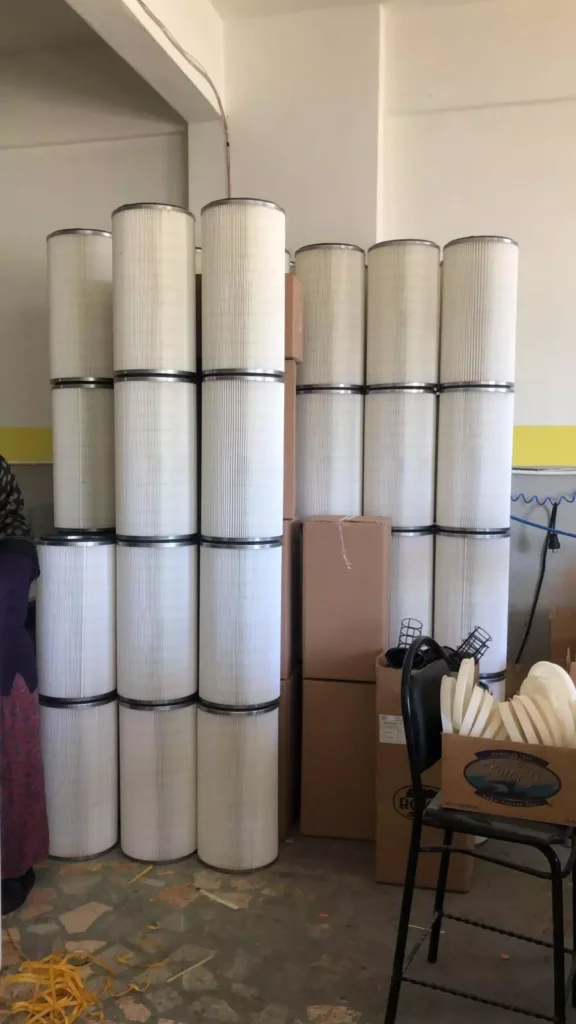
Powder coating filters are an essential component of automatic powder coating booths. They help to remove overspray powder coating from the air, preventing it from contaminating the environment and harming workers.
There are two main types of powder coating filters: cartridge filters and bag filters.
Cartridge filters are the most common type of powder coating filter. They are made up of a cylinder of pleated filter material that is encased in a metal housing. Cartridge filters are very effective at removing overspray powder coating from the air, but they can be expensive to replace.
Bag filters are less expensive than cartridge filters, but they are not as effective at removing overspray powder coating from the air. Bag filters are typically made up of a large cloth bag that is suspended from a metal frame. When the bag filter becomes clogged with powder coating, it can be emptied and reused.
How powder coating filters work
Powder coating filters work by trapping overspray powder coating particles in the filter material. When the air containing overspray powder coating is drawn through the filter, the powder coating particles are captured by the filter material and prevented from passing through.
Benefits of using powder coating filters in automatic powder coating booths
There are a number of benefits to using powder coating filters in automatic powder coating booths, including:
- Improved air quality: Powder coating filters help to improve the air quality in the powder coating booth by removing overspray powder coating from the air. This can help to protect workers from inhaling harmful powder coating particles.
- Reduced environmental impact: Powder coating filters help to reduce the environmental impact of powder coating operations by preventing overspray powder coating from being released into the environment.
- Improved efficiency: Powder coating filters can help to improve the efficiency of the powder coating process by reducing the amount of overspray powder coating that needs to be reclaimed.
- Extended oven life: Powder coating filters can help to extend the life of the powder coating oven by preventing overspray powder coating from clogging the oven’s filters.
How to choose the right powder coating filter for your automatic powder coating booth
When choosing a powder coating filter for your automatic powder coating booth, there are a few factors to consider:
- The type of powder coating being used: Different types of powder coating require different types of filters. For example, epoxy powder coatings require filters that are specifically designed to remove epoxy powder coating particles from the air.
- The production volume: If you have a high-volume powder coating operation, you will need a filter that can handle the high volume of overspray powder coating.
- The budget: Powder coating filters can range in price from a few hundred dollars to several thousand dollars. It is important to set a budget before making a purchase.
Conclusion
Powder coating filters are an essential component of automatic powder coating booths. They help to improve air quality, reduce environmental impact, improve efficiency, and extend oven life. When choosing a powder coating filter for your automatic powder coating booth, it is important to consider the type of powder coating being used, the production volume, and the budget.tunesharemore_vert
During the painting process, the paint which did not stick on the part, with the effect of the suction valve, by sticking on the filters their extrusion to the external environment is avoided.
The paint is poured onto a powder hopper with a sieve as the filters are cleaned through a reverse washing line (pulse valves). To clean the filters, compressed air is transmitted into the filters automatically. This process is fulfilled by means of the pulse valves commanded by the electronic card.
Design and Function of Powder Filter Units
Powder filter units are produced for mass production areas. EMS powder filter units are designed to be cleaned easily and to be managed by a PLC system. A few significant features are listed below;
-High-efficiency filtration.
-Proper for continuously working lines.
-Strength filter.
Function definition
While the filter unit is in operation, the contaminated air enters through the inlet of the filter unit and passes through the filter cartridges. The powder/dye mixture is collected on the outside of the filters. The filtered air passes through the filters and it is returned from the output filter as clean air to the ambient.
The filter cartridges are automatically cleaned at regular intervals. Thus, the filter units can be used efficiently. During the cleaning of the filter unit, the timer sends energy to the solenoid valve and it is given compressed air from the diaphragm valve to the filters at the same time. ( to outward from the inside of the filters.)
Therefore, The powder/dye mixture which is collected outside of the filter pours under the filter unit and it is cumulated in the waste storage. With the aid of the fan on the filter unit, firstly, the dust passes through from air canals in the plastic powder coating booth. It is held in filters after passes from the cyclone separator. It is ensured the air that is given outside can keep clean. Besides, air/powder mixture concentration can keep away from explosion potential interval because of the suction fan speed
Plastic Spray booth manufacturers try to solve the cleaning problem after each color change by either inventing a new powder coating booth design or applying new antistatic materials for the booth construction. As the powder coating cost increases in accordance with the energy prices, companies need smaller stops between each color change.
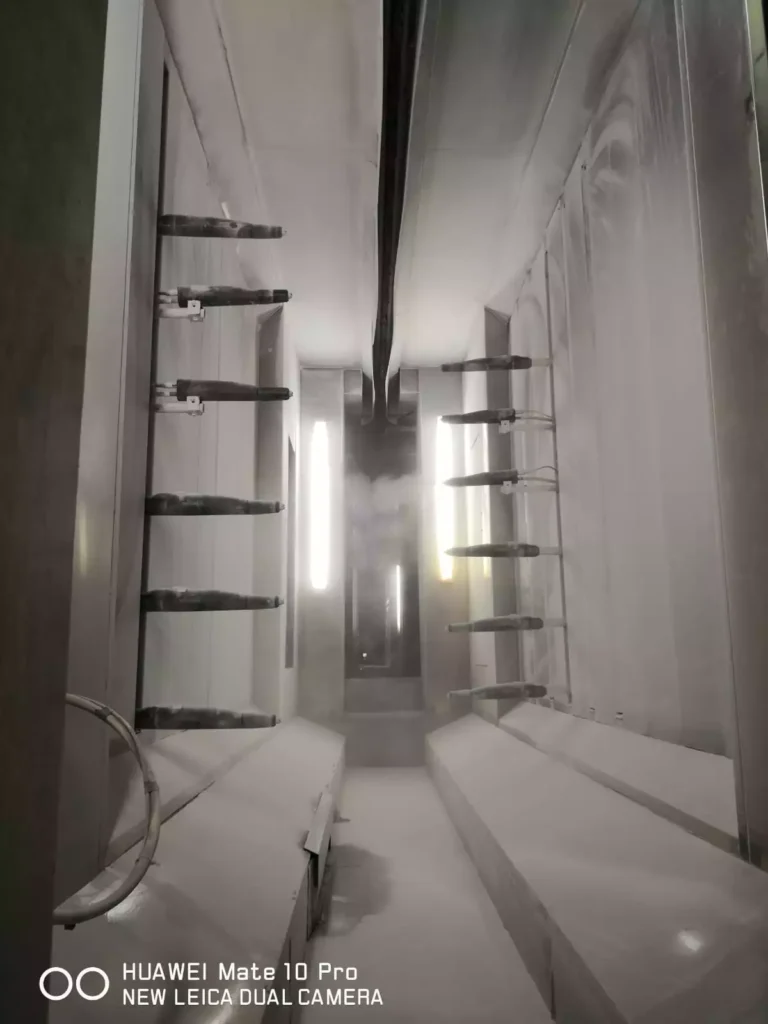
The Setup and Startup of the Filter Unit
It is needed to apply the following substances if the first time operation or long periods of stoppage.
- Make sure that there is no dust/impurity on the fan outlet.
- Make sure that the waste storage is placed under the filter unit.
- Set the air damper to a 75% open position.
- 4)Make sure that the inspection hatch is closed.
- Turn on the energy from the switch.
- Measure the air flow with a micromanometer and set the airflow through the damper. If the air stream is higher than the level wanted, the fan and the filter lifetime reduce seriously.( It should be done by an authorized service.)
- Give the compressor air and set it to 6 bar. Above 7 bar of air can damage the filter.
Application of the Filter Unit
Before every operation, apply the above following.
- Read all user manuals, which are sent with the filter unit instructions.
- Check the grounding of the filter unit
- Listen to the fan noise. If exists noise is more than the normal level, the fan can be problematic.
- If it is proper, test the filter unit functions
During long stances - Clean the clean air room.
- Check the pulse valve timer. ( It should be done by an authorized service.)
- Check the waste storage of the filter unit to be sure in its place. If it is needed, it can be emptied.
- Check the compressor air and air/ water concentration.
- Check the pulse valve for air leaks.
- Check the door of the filter against leakage.
- Check the elbow for air leaks.
- The filters should be changed after using 2 years. ( for the one shift)
In operation,
-Operate the compressor and set up inlet pressure. ( generally 6 bar)
-Turn on the main switch.
-Check the operation of the system and control data of guns from the main control cabinet.
While stopping operation,
-If the booth is managed automatically, stop automatic mode.
-Turn off control units.
-Switch off the booth.
-Switch off the powder center management.
-Turn off the main switch.
Filter Cleaning of the Automatic Powder Coating Booth
-Filter units are cleaned by compressed air at factory-set intervals.Each filter takes 300 seconds.
-Filters have to be changed. Changing time for filters can be understood by the differential pressure gauge which is located on the filter unit.
-When the pressure reaches 1750 Pa level, It is needed to alter filters.
-This process can be applied by EMS personnel or employees who are educated by EMS personnel. All changes again must be made by these employees.
Filter Change of the Automatic Powder Coating Booth
a.De-energize.
b.Open the doors of the filter unit.
c.Loosen the knob which is under the filter unit but it should not be removed.
d.Push the filter with reciprocating motion and remove it from the hook.
e.Place the new filter by pushing it towards the hook.
f.Tighten down the knob under the filter.
g.Close the doors of the filter unit.
Advantages of PVC Plastic Powder Coating Booth

- Easier to clean which decreases color change time
- Lighter to transport
- Long service life
- Flexibility in production
- High quality in powder finishing
- The less lost powder decreases the cost of powder coating
- Adaptable to different part dimensions with a changeable entrance width
The coating material doesn’t play a role in powder coating in a plastic booth as the standard electrostatic powder application doesn’t change. The guns are charged with high voltage and they apply this high voltage onto the powder coating.
Daily Maintenance of the Automatic Powder Coating Booth
•Before operating the booth ;
1. Make sure that the filters are in place.
2. Check the swept powder paint hopper, if it is in place and fixed.
3. If available, check the exit filters and waste paint hopper, if they are in place and mounted by compression nuts.
4. Check the painting robots and guns, if they are operating successfully.
5. Check the swept powder paint hopper, if it has enough paint in hopper.
6. Check the air of the cabin; air pressure should be 6 bar.
7. Check the air dryer and compressor and empty the waste water and make sure that dry air is flowing into the cabinet.
8. Make sure that there is no air flowing at the environment that brings dust, dirt, etc. into the cabinet. So, shut the doors and windows.
•At the end of the daily shift ;
9. While the fan is operating, collect the paints that are poured on the floor and wall of the cabinet by sweeping through a broom like a glass wiper.
10. Put the paints, collected in the swept powder paint hopper, in the package and close it. This procedure prevents the dampening of the powder paint.
11. Make sure that there is no air flowing at the environment that brings dust, dirt, etc. into the cabinet. So, shut the doors and windows.
12. Leave the manual painting doors as closed.
•Cleaning of the cabinet;
13. While the fan is operating, collect the paints that are poured on the floor or wall of the cabinet by sweeping through a broom like a glass wiper.
14. While the fan is operating, collect the paints that remained on the floor or wall in the swept powder paint hopper by directing
them to filter group through pressured air.
15. Pour the paint on the filters down via pulsation of the valves manually.
16. Close the suction fans.
17. Rip the filters and pour the paints on the filters in the swept hopper by flapping manually.
18. Rip the swept powder paint hopper; put the paints in the hopper to the package and close it.
19. Clean the swept hopper and inner part of the cabinet through a humid cloth completely.
20. Clean the paint guns, hoses, injectors, etc., through pressured air.
21. Replace the filters for new painting color; put the new paint in the swept hopper; and prepare other painting equipment to
operate. The powder paint booth is ready to operate in a new color.
Powder Coating: An In-Depth Guide to Equipment and Processes
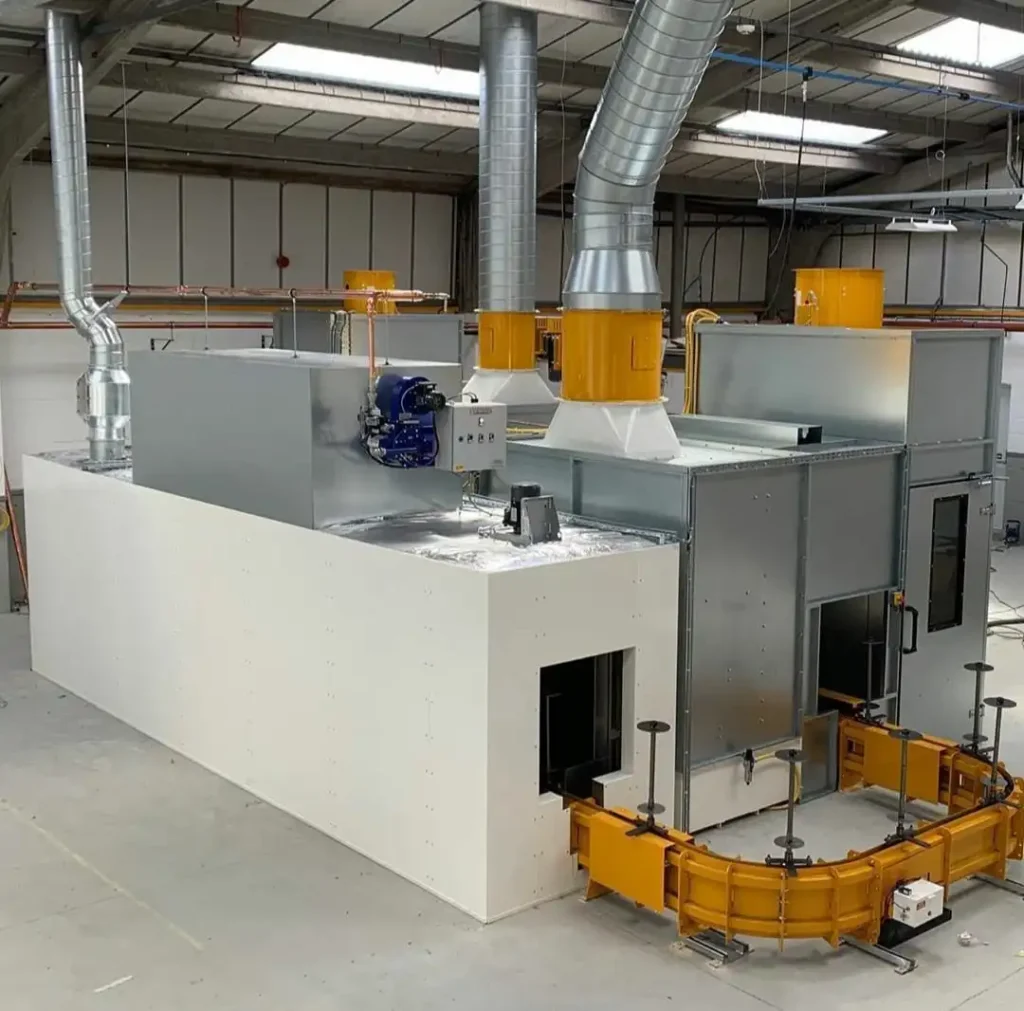
Introduction
Powder coating is a popular finishing process used across various industries to apply a durable and protective layer to metal surfaces. Unlike traditional liquid paint, powder coating uses a dry powder that is electrostatically charged and applied to the surface, which is then cured in a high-temperature oven. This process results in a hard finish that is more resistant to chipping, scratching, and fading.
In this guide, we’ll explore the different components of a powder coating system, including ovens, machines, equipment, and entire production lines. Understanding these elements is crucial for businesses looking to enhance their production capabilities with powder coating technology.
Powder Coating Ovens
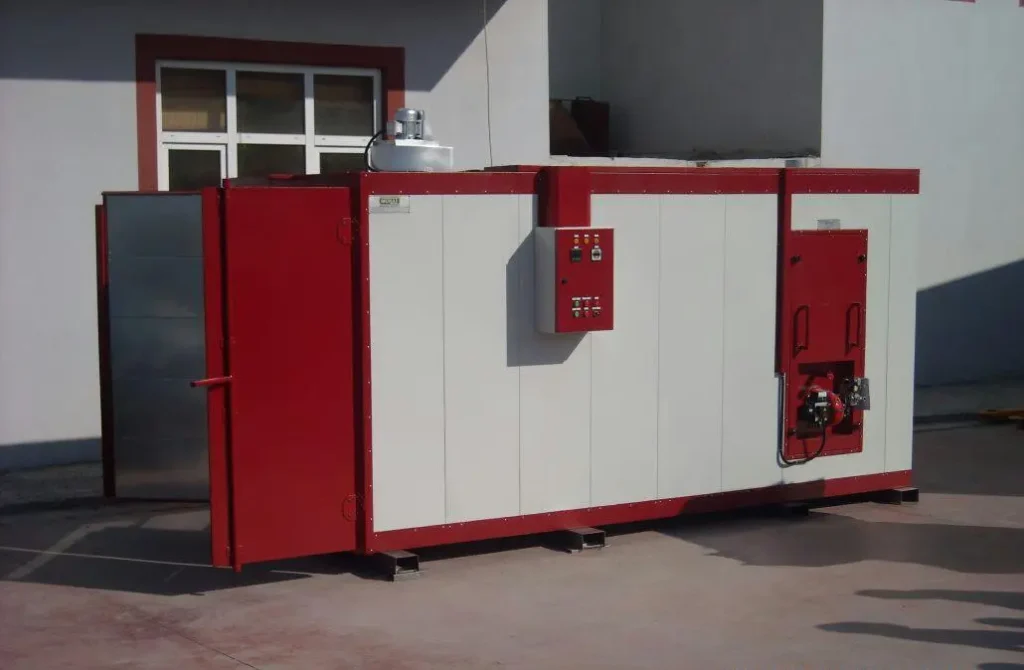
Definition and Purpose:
Powder coating ovens are essential for the curing process, where the powder adheres to the surface and forms a smooth, hard finish. These ovens provide the necessary heat to melt the powder, ensuring even and thorough coating.
Types of Powder Coating Ovens:
- Batch Ovens:
- Ideal for small to medium-sized production runs
- Flexibility to handle various part sizes
- Suitable for businesses with diverse product lines
- Conveyor Ovens:
- Designed for continuous production
- Higher throughput and efficiency
- Suitable for large-scale operations
Features and Specifications:
- Temperature Range: Typically between 325°F to 450°F
- Heating Source: Options include electric, gas, or infrared
- Size and Capacity: Varies based on production needs
- Energy Efficiency: Consider models with advanced insulation and airflow systems
How to Choose the Right Oven:
- Evaluate production volume and part sizes
- Consider energy consumption and operating costs
- Assess available space and installation requirements
- Consult with manufacturers for customized solutions
Powder Coating Machines
Overview of Different Machines Used:
Powder coating machines are used to apply the powder to the surface. They vary in complexity and functionality, catering to different production needs.
Manual vs. Automated Machines:
- Manual Machines:
- Suitable for small-scale operations
- Offers flexibility and control
- Requires skilled operators
- Automated Machines:
- Ideal for high-volume production
- Consistent and uniform application
- Reduced labor costs
Key Features and Specifications:
- Voltage and Power Requirements: Ensure compatibility with your facility
- Control Systems: Look for user-friendly interfaces and programmable settings
- Spray Gun Options: Different nozzles and gun types for various applications
Selecting the Right Machine for Your Needs:
- Determine the scale and complexity of your operations
- Evaluate budget constraints and long-term ROI
- Seek advice from industry experts and suppliers
Powder Coating Equipment
Essential Equipment for Powder Coating:
- Powder Coating Booths: Enclosed areas for applying powder
- Powder Recovery Systems: Capture and reuse overspray powder
- Air Compressors and Dryers: Ensure consistent airflow for optimal coating
Optional Equipment for Enhanced Performance:
- Pre-Treatment Systems: Clean and prepare surfaces before coating
- Curing Lamps: Speed up the curing process with infrared or UV lamps
Maintenance and Safety Considerations:
- Regularly inspect and clean equipment
- Train staff on proper handling and safety protocols
- Adhere to industry standards and regulations
Powder Coating Lines and Plants
Explanation of Powder Coating Lines:
Powder coating lines are integrated systems that automate the entire powder coating process, from pre-treatment to curing.
Components of a Powder Coating Line:
- Conveyor Systems: Move parts through the line efficiently
- Pre-Treatment Stations: Clean and prepare surfaces
- Powder Application Booths: Enclosed areas for powder coating
- Curing Ovens: Finalize the coating process
Design and Layout Considerations:
- Optimize workflow and space utilization
- Consider future scalability and expansion
- Ensure compliance with safety and environmental regulations
Scalability and Customization Options:
- Modular designs for easy expansion
- Custom configurations to meet specific production needs
Benefits of Powder Coating
Environmental Advantages:
- Low VOC emissions compared to liquid paints
- Overspray can be recycled, reducing waste
- Complies with environmental regulations
Durability and Longevity:
- Resistant to corrosion, fading, and wear
- Suitable for outdoor and high-traffic applications
- Provides a high-quality, professional finish
Cost-Effectiveness:
- Reduces long-term maintenance and repainting costs
- Efficient use of materials minimizes waste
- High throughput and automation lower labor expenses
Considerations for Setting Up a Powder Coating Plant
Initial Investment and ROI:
- Assess capital requirements for equipment and infrastructure
- Calculate potential returns based on production capacity and demand
- Explore financing options and incentives
Regulatory Compliance:
- Adhere to industry standards and local regulations
- Implement safety protocols and employee training
- Monitor environmental impact and waste management
Market Trends and Future Outlook:
- Growing demand for eco-friendly coatings
- Advancements in automation and technology
- Increasing adoption in automotive, aerospace, and consumer goods sectors
Conclusion
Powder coating offers numerous advantages over traditional liquid painting methods, making it an attractive option for industries seeking durable and environmentally friendly finishes. By investing in the right equipment and understanding the intricacies of powder coating processes, businesses can enhance their production capabilities and meet the growing demand for high-quality coated products.
When setting up a powder coating plant, it’s essential to carefully consider your needs, budget, and long-term goals. Collaborating with experienced suppliers and industry experts can help you make informed decisions and achieve success in the competitive world of powder coating.
This comprehensive guide should provide valuable insights for your website visitors and help position your business as a knowledgeable and reliable source in the powder coating industry.
Installation process steps
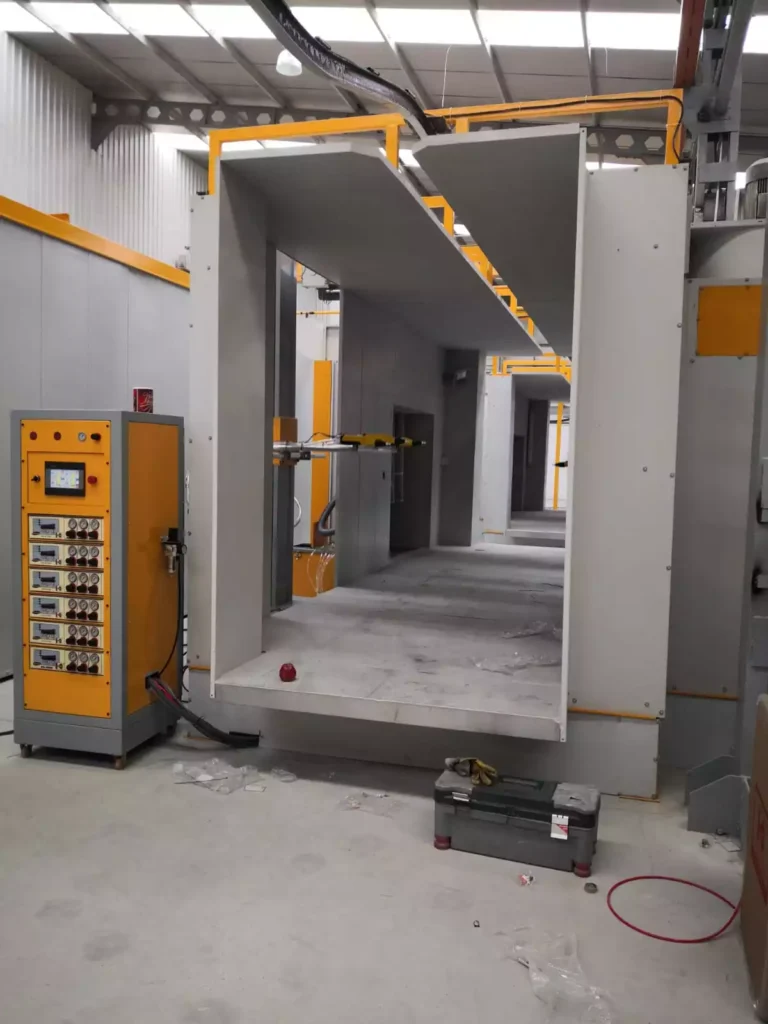
To provide a comprehensive guide on the installation process for powder coating systems, we’ll cover each step involved in setting up a powder coating plant. This includes planning, selecting equipment, site preparation, installation, testing, and staff training. Here’s a detailed outline and content for this section:
Outline for Installation Process Steps
- Planning and Design
- Assessing needs and capacity
- Layout and design considerations
- Budget and timeline
- Equipment Selection
- Choosing the right ovens, machines, and equipment
- Consulting with manufacturers and suppliers
- Site Preparation
- Preparing the facility for installation
- Ensuring compliance with regulations
- Installation Process
- Step-by-step installation guide
- Safety protocols and considerations
- System Testing and Calibration
- Testing each component
- Ensuring optimal performance
- Training and Support
- Staff training on operation and safety
- Ongoing maintenance and support
- Post-Installation Considerations
- Regular inspections and maintenance
- Upgrades and scalability
Installation Process Steps for Powder Coating Systems

Setting up a powder coating plant involves careful planning and execution to ensure a successful installation. Here’s a step-by-step guide to help you navigate the process:
1. Planning and Design
Assessing Needs and Capacity:
- Identify Production Requirements: Determine the types and sizes of parts you will be coating, and estimate your production volume.
- Analyze Workflow: Consider how materials will move through the plant, from pre-treatment to curing.
- Evaluate Space Requirements: Ensure adequate space for equipment, storage, and workflow efficiency.
Layout and Design Considerations:
- Optimize Workflow: Design a layout that minimizes bottlenecks and maximizes efficiency.
- Future Scalability: Plan for potential expansion or upgrades.
- Compliance with Safety Standards: Ensure the layout meets all safety and regulatory requirements.
Budget and Timeline:
- Create a Detailed Budget: Account for equipment, installation, training, and operational costs.
- Establish a Timeline: Set realistic milestones for each phase of the installation process.
2. Equipment Selection
Choosing the Right Ovens, Machines, and Equipment:
- Powder Coating Ovens: Select between batch or conveyor ovens based on production needs.
- Powder Coating Machines: Choose manual or automated systems that match your operational scale.
- Additional Equipment: Consider powder booths, recovery systems, and pre-treatment stations.
Consulting with Manufacturers and Suppliers:
- Leverage Expertise: Work with manufacturers to choose equipment tailored to your specific requirements.
- Request Demonstrations: Evaluate equipment performance through demos or site visits.
- Negotiate Contracts: Ensure favorable terms and warranties with suppliers.
3. Site Preparation
Preparing the Facility for Installation:
- Infrastructure Readiness: Ensure adequate power supply, ventilation, and environmental controls.
- Space Optimization: Clear and organize the installation area for easy access and efficient workflow.
Ensuring Compliance with Regulations:
- Local Permits and Licenses: Obtain necessary permits and ensure compliance with zoning regulations.
- Safety Standards: Adhere to occupational health and safety standards.
4. Installation Process
Step-by-Step Installation Guide:
- Site Inspection: Conduct a final inspection of the site to verify readiness.
- Delivery and Unpacking: Receive and unpack equipment carefully, checking for any damage.
- Positioning Equipment: Install each piece of equipment according to the layout plan.
- Electrical and Plumbing Connections: Ensure all electrical and plumbing connections are correctly made and tested.
- Calibration and Setup: Configure equipment settings and calibrate machinery to specifications.
Safety Protocols and Considerations:
- Install Safety Features: Implement necessary safety features such as emergency stops and protective barriers.
- Personal Protective Equipment (PPE): Ensure that all personnel have access to required PPE.
5. System Testing and Calibration
Testing Each Component:
- Conduct Trial Runs: Test each component individually and as part of the integrated system.
- Check for Performance Issues: Identify and resolve any performance or operational issues.
Ensuring Optimal Performance:
- Fine-Tune Settings: Adjust equipment settings for optimal coating quality.
- Document Results: Record all testing results and adjustments for future reference.
6. Training and Support
Staff Training on Operation and Safety:
- Conduct Training Sessions: Provide comprehensive training on equipment operation and safety protocols.
- Create Training Materials: Develop manuals and guides for ongoing staff reference.
Ongoing Maintenance and Support:
- Establish a Maintenance Schedule: Set up regular maintenance checks to ensure equipment longevity.
- Vendor Support: Engage with suppliers for ongoing support and troubleshooting.
7. Post-Installation Considerations
Regular Inspections and Maintenance:
- Implement Routine Inspections: Regularly inspect equipment and systems for wear and tear.
- Schedule Maintenance: Adhere to the maintenance schedule to prevent downtime and extend equipment life.
Upgrades and Scalability:
- Monitor Technological Advancements: Stay informed about new technologies and equipment improvements.
- Plan for Upgrades: Budget for future upgrades and expansion as business needs grow.
Conclusion
The installation of a powder coating system is a multi-step process that requires meticulous planning and execution. By following these steps, businesses can ensure a smooth setup and operation, maximizing efficiency and product quality. It’s crucial to work closely with experienced manufacturers and suppliers to tailor the installation process to your specific needs and to provide ongoing training and support for staff.
Installation cost estimate

Estimating the installation cost of a powder coating system involves considering various factors, such as the size of the operation, the type of equipment, facility modifications, labor, and additional costs like permits and training. Here’s a detailed breakdown to help you understand the potential costs involved in setting up a powder coating plant.
Installation Cost Estimate for Powder Coating Systems
Factors Influencing Costs
- Type of Equipment and Technology
- Powder coating ovens (batch vs. conveyor)
- Coating machines (manual vs. automated)
- Auxiliary equipment (booths, recovery systems, pre-treatment stations)
- Scale and Capacity of the Operation
- Production volume
- Facility size and space requirements
- Facility Modifications
- Infrastructure updates (electrical, ventilation, plumbing)
- Space optimization and layout design
- Labor and Installation Services
- Skilled labor for installation
- Equipment calibration and testing
- Additional Costs
- Permits and regulatory compliance
- Staff training and support
- Maintenance and contingency expenses
Estimated Costs
Below is a general estimate of the costs associated with installing a powder coating system. Note that prices can vary significantly based on location, vendor, and specific requirements.
1. Equipment Costs
- Powder Coating Ovens:
- Batch Ovens: $1,000 – $50,000
- Conveyor Ovens: $10,000 – $200,000
- Powder Coating Machines:
- Manual Machines: $1,000 – $20,000
- Automated Systems: $20,000 – $100,000
- Auxiliary Equipment:
- Powder Booths: $2,000 – $30,000
- Recovery Systems: $3,000 – $15,000
- Pre-Treatment Systems: $10,000 – $50,000
2. Facility Modifications
- Electrical and Ventilation Upgrades: $10,000 – $50,000
- Space Optimization and Layout Design: $5,000 – $20,000
3. Labor and Installation Services
- Installation Labor: $10,000 – $30,000
- Calibration and Testing: $5,000 – $10,000
4. Additional Costs
- Permits and Compliance: $2,000 – $10,000
- Training and Support: $2,000 – $5,000
- Maintenance and Contingency: $5,000 – $15,000
Total Estimated Cost
The total estimated cost for installing a powder coating system can range from $70,000 to $500,000, depending on the size, complexity, and specific requirements of the operation. Here’s a breakdown by scale:
- Small-Scale Operations: $20,000 – $50,000
- Medium-Scale Operations: $50,000 – $100,000
- Large-Scale Operations: $100,000 – $500,000
Tips for Cost Management
- Conduct a Detailed Assessment:
- Evaluate your specific needs and choose equipment accordingly.
- Consider future scalability to avoid unnecessary upgrades later.
- Get Multiple Quotes:
- Request quotes from multiple vendors to compare prices and services.
- Negotiate terms and warranties to get the best deal.
- Plan for Contingencies:
- Set aside a contingency budget for unexpected expenses during installation.
- Regularly review and adjust your budget as the project progresses.
- Focus on Energy Efficiency:
- Invest in energy-efficient equipment to reduce long-term operational costs.
- Evaluate the potential return on investment (ROI) for each piece of equipment.
- Leverage Financing Options:
- Explore financing options, grants, or incentives available for industrial upgrades.
Conclusion
Setting up a powder coating plant requires a significant investment, but careful planning and strategic decision-making can help manage costs effectively. By considering your specific needs, working with experienced suppliers, and planning for the future, you can ensure a successful installation and operation of your powder coating system.
Let me know if you need further details or specific cost estimates tailored to your project!
Components of a Powder Coating Plant
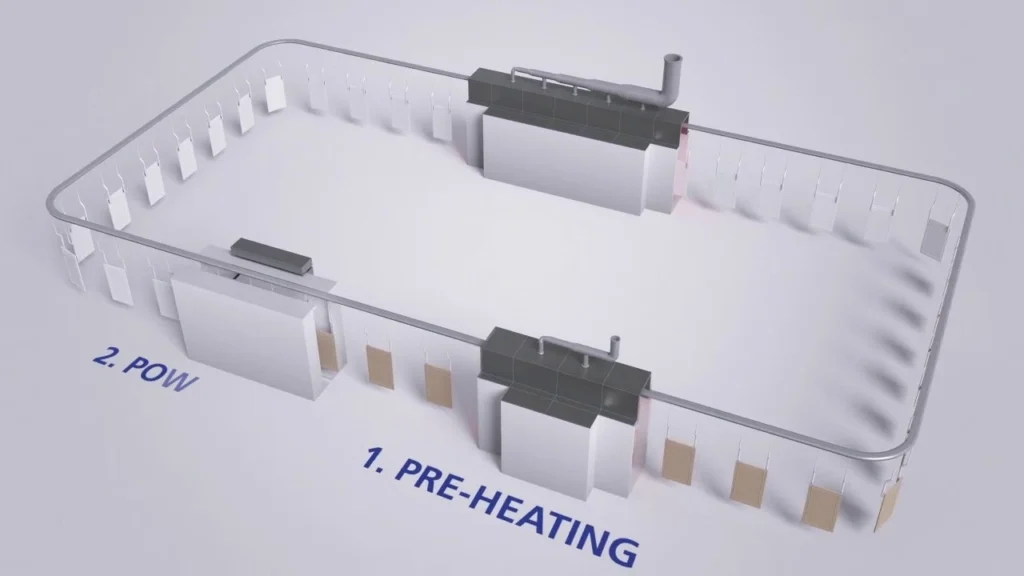
A powder coating plant consists of various components that work together to facilitate the coating process, from preparation to application and curing. Understanding these components is crucial for designing an efficient and effective system tailored to specific production needs. Below is a detailed overview of the key components of a powder coating plant:
Key Components of a Powder Coating Plant
- Pre-Treatment System
- Purpose: Cleans and prepares surfaces for powder coating to ensure adhesion and finish quality.
- Components:
- Washing Stations: Use chemical solutions to remove contaminants like grease, oil, dirt, and rust.
- Rinse Stations: Remove residual chemicals from the surface.
- Drying Ovens: Dry the parts after washing and rinsing to prepare them for powder application.
- Powder Coating Booths
- Purpose: Enclosed area where the powder is applied to the parts.
- Types:
- Manual Booths: Operators manually apply powder using spray guns. Ideal for small or custom jobs.
- Automatic Booths: Equipped with automated spray guns and reciprocators for high-volume production.
- Features:
- Ventilation Systems: Ensure proper airflow to capture overspray and maintain a clean environment.
- Powder Recovery Systems: Collect overspray powder for reuse, improving material efficiency.
- Powder Application Equipment
- Purpose: Applies the powder to the surfaces using electrostatic spray guns.
- Components:
- Electrostatic Spray Guns: Charge the powder particles and spray them onto the grounded parts.
- Control Units: Adjust settings like voltage, powder flow rate, and air pressure to ensure uniform coverage.
- Conveyor System
- Purpose: Transports parts through various stages of the powder coating process.
- Types:
- Overhead Conveyors: Hang parts from hooks or racks for continuous production.
- Floor Conveyors: Suitable for heavier or larger parts that cannot be suspended.
- Features:
- Variable Speed Control: Adjusts the speed of the conveyor to match production needs and curing times.
- Loading and Unloading Stations: Facilitate the movement of parts onto and off the conveyor system.
- Powder Coating Ovens
- Purpose: Cures the powder coating by melting and fusing it to the surface, forming a durable finish.
- Types:
- Batch Ovens: Suitable for smaller production runs and varied part sizes.
- Conveyor Ovens: Designed for continuous, high-volume production.
- Features:
- Temperature Control Systems: Ensure precise and consistent heating for optimal curing.
- Energy Efficiency: Incorporate insulation and heat recovery systems to minimize energy consumption.
- Cooling and Inspection Stations
- Purpose: Cool the parts after curing and inspect them for quality assurance.
- Components:
- Cooling Zones: Allow parts to cool gradually to avoid warping or defects.
- Inspection Areas: Check for coating consistency, thickness, and finish quality before packaging or assembly.
- Control and Monitoring Systems
- Purpose: Manage and monitor the entire powder coating process for efficiency and quality control.
- Components:
- PLC Systems (Programmable Logic Controllers): Automate and synchronize various plant operations.
- Data Logging and Analysis Tools: Record production metrics and identify areas for improvement.
- Safety and Environmental Controls
- Purpose: Ensure the safety of workers and compliance with environmental regulations.
- Components:
- Fire Suppression Systems: Protect against powder fires or explosions in booths and ovens.
- Ventilation and Filtration Systems: Maintain air quality by removing dust, fumes, and volatile organic compounds (VOCs).
- Personal Protective Equipment (PPE): Provide workers with necessary safety gear, such as masks, gloves, and goggles.
Optional and Auxiliary Components
- Advanced Pre-Treatment Systems: Utilize additional technologies like ultrasonic cleaning or nanotechnology for improved surface preparation.
- Curing Lamps: Use infrared or UV lamps for faster curing times and energy savings.
- Automated Robotic Systems: Enhance precision and efficiency in powder application and handling.
- Quality Control Instruments: Use advanced tools like thickness gauges, gloss meters, and adhesion testers for detailed quality assessment.
Layout and Design Considerations
- Workflow Optimization: Design the plant layout to minimize bottlenecks and ensure smooth transitions between stages.
- Space Utilization: Efficiently allocate space for equipment, storage, and movement of materials.
- Scalability: Plan for future expansion or upgrades to accommodate growing production demands.
Conclusion
A well-designed powder coating plant integrates these components to create an efficient, high-quality coating process. Understanding each element and its role in the system is crucial for businesses looking to enhance their powder coating capabilities. By investing in the right equipment and technology, companies can achieve superior finishes, increased productivity, and long-term success in the powder coating industry.
Detailed Components of a Powder Coating Plant
Certainly! To provide a detailed understanding of each component within a powder coating plant, we’ll delve into the technical specifications, functions, types, and key considerations for each element. This comprehensive breakdown will cover everything from the initial pre-treatment to the final inspection.
1. Pre-Treatment System

Overview
The pre-treatment system is crucial in ensuring that surfaces are properly cleaned and prepared for powder coating. This step enhances adhesion, improves finish quality, and increases the longevity of the coating.
Components and Process
1.1. Cleaning and Degreasing Stations
- Purpose: Remove oils, grease, and other contaminants from the surface.
- Methods:
- Alkaline Cleaning: Uses alkaline solutions to break down grease and oils.
- Solvent Cleaning: Employs organic solvents to dissolve contaminants.
- Ultrasonic Cleaning: Utilizes high-frequency sound waves for deep cleaning, especially effective for complex shapes.
- Equipment:
- Tanks and spray systems
- Heating elements to improve cleaning efficiency
- Agitation systems for even cleaning
1.2. Rinse Stations
- Purpose: Eliminate residual chemicals and contaminants from the cleaning stage.
- Types of Rinse:
- Freshwater Rinse: Basic water rinse to remove chemicals.
- Deionized Water Rinse: Prevents mineral deposits and spots on surfaces.
- Equipment:
- Spray bars and nozzles for thorough rinsing
- Closed-loop systems to recycle water and reduce waste
1.3. Surface Conditioning
- Purpose: Prepare the surface for subsequent conversion coating.
- Processes:
- Acid Etching: Removes oxides and prepares metal surfaces.
- Descaling: Removes scale and rust from the surface.
- Equipment:
- Immersion tanks or spray booths
- Automated dosing systems for precise chemical application
1.4. Conversion Coating
- Purpose: Apply a chemical layer that enhances powder adhesion and corrosion resistance.
- Types:
- Phosphate Coating: Iron or zinc phosphate for steel surfaces.
- Chromate Coating: Used for aluminum and zinc surfaces.
- Nano-Ceramic Coatings: Environmentally friendly option with superior adhesion and corrosion resistance.
- Equipment:
- Spray or immersion systems
- Temperature control for optimal reaction conditions
1.5. Drying Ovens
- Purpose: Remove moisture from parts to prevent defects in the powder coating.
- Features:
- Adjustable temperature settings
- Air circulation systems for even drying
- Equipment:
- Batch ovens for smaller production
- Conveyor ovens for continuous processing
Key Considerations
- Chemical Management: Ensure proper handling, storage, and disposal of chemicals used in pre-treatment.
- Environmental Compliance: Adhere to local regulations for effluent discharge and waste management.
- Maintenance: Regular cleaning and inspection of tanks and nozzles to prevent contamination.
2. Powder Coating Booths
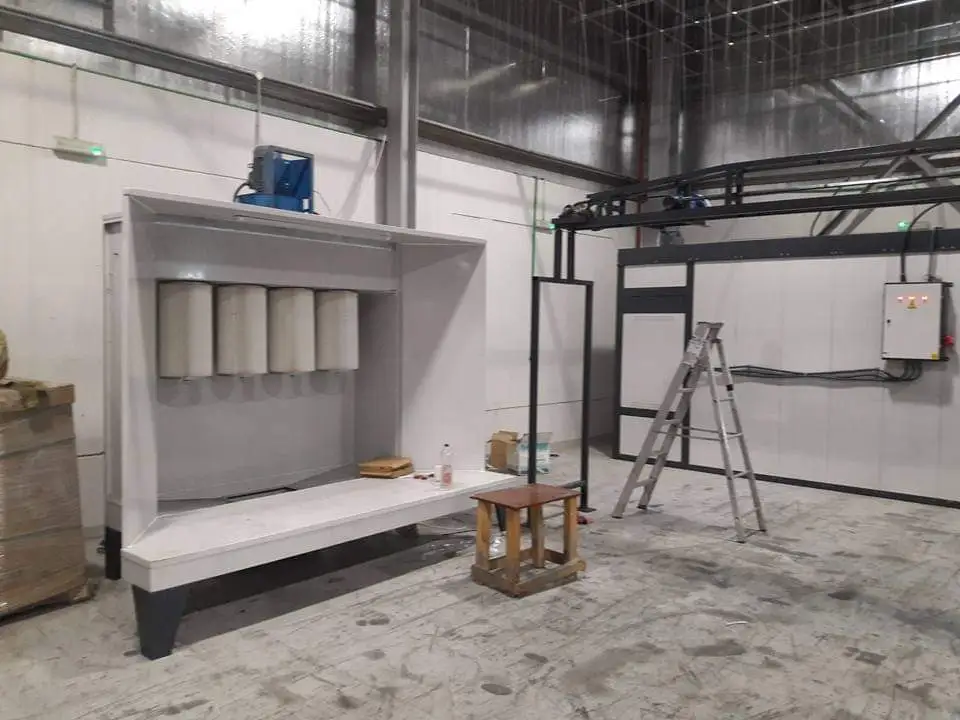
Overview
Powder coating booths provide a controlled environment for applying the powder. They ensure that the powder is applied evenly and that any overspray is efficiently managed and collected for reuse.
Types and Features
2.1. Manual Powder Coating Booths
- Purpose: Allow operators to manually apply powder using handheld spray guns.
- Applications: Suitable for small batches, custom jobs, and intricate parts.
- Features:
- Ventilation Systems: Maintain air quality and remove overspray.
- Lighting: Ensure visibility for precise application.
- Ergonomic Design: Facilitate operator comfort and efficiency.
2.2. Automatic Powder Coating Booths
- Purpose: Use automated systems to apply powder to parts, ideal for high-volume production.
- Applications: Suitable for standard parts and large-scale operations.
- Features:
- Robotic Arms and Reciprocators: Ensure consistent application across parts.
- Programmable Settings: Customize application parameters for different parts.
- Rapid Color Change Systems: Allow quick and efficient color changes with minimal downtime.
2.3. Powder Recovery Systems
- Purpose: Capture and recycle overspray powder to improve efficiency and reduce waste.
- Types:
- Cyclone Separators: Use centrifugal force to separate powder from the air.
- Cartridge Filters: Trap fine powder particles for reuse.
- Baghouse Filters: Employ fabric bags to capture powder, suitable for larger particles.
Key Considerations
- Airflow Management: Ensure proper ventilation to prevent contamination and maintain a clean environment.
- Color Change Efficiency: Invest in systems that allow quick and easy color changes to minimize downtime.
- Safety: Implement explosion-proof designs and fire suppression systems to prevent hazards.
3. Powder Application Equipment
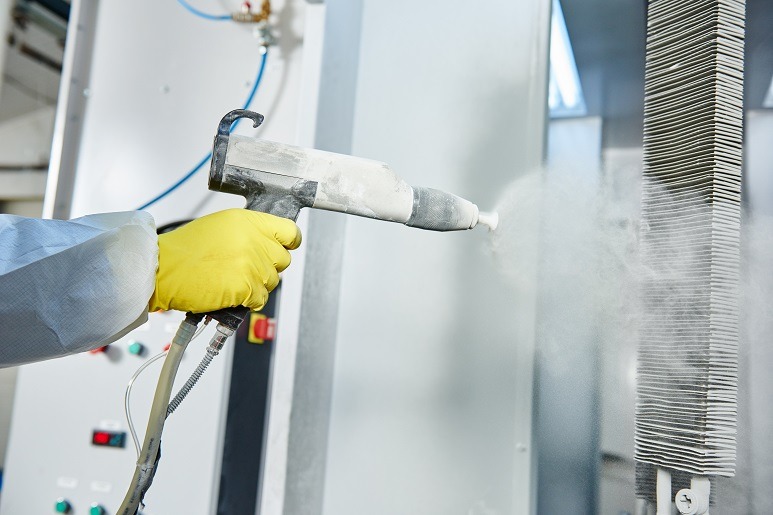
Overview
Powder application equipment is responsible for applying the powder coating to the parts. This equipment uses electrostatic principles to ensure uniform coverage and strong adhesion.
Components and Features
3.1. Electrostatic Spray Guns
- Purpose: Apply powder to the parts using an electrostatic charge.
- Types:
- Corona Guns: Use a high-voltage electrode to charge the powder.
- Tribo Guns: Charge the powder through friction, suitable for specific applications.
- Features:
- Adjustable Voltage and Current: Control the electrostatic charge for optimal coverage.
- Interchangeable Nozzles: Provide different spray patterns for various applications.
- Lightweight and Ergonomic Design: Ensure operator comfort during manual application.
3.2. Control Units
- Purpose: Manage and adjust the settings of the powder application equipment.
- Features:
- Digital Displays: Provide real-time feedback on settings and performance.
- Programmable Settings: Allow customization for different parts and powder types.
- Data Logging: Record application parameters for quality control and traceability.
3.3. Fluidized Bed Systems
- Purpose: Coat parts by dipping them into a bed of fluidized powder, typically used for thicker coatings.
- Applications: Suitable for specific applications requiring a thick and even coating.
- Features:
- Uniform Airflow: Ensure consistent fluidization of powder particles.
- Temperature Control: Maintain optimal conditions for coating.
Key Considerations
- Powder Compatibility: Ensure equipment is compatible with different powder formulations.
- Operator Training: Provide comprehensive training for operators to ensure efficient and safe use.
- Maintenance: Regularly clean and maintain spray guns and control units to prevent clogging and ensure consistent performance.
4. Conveyor System
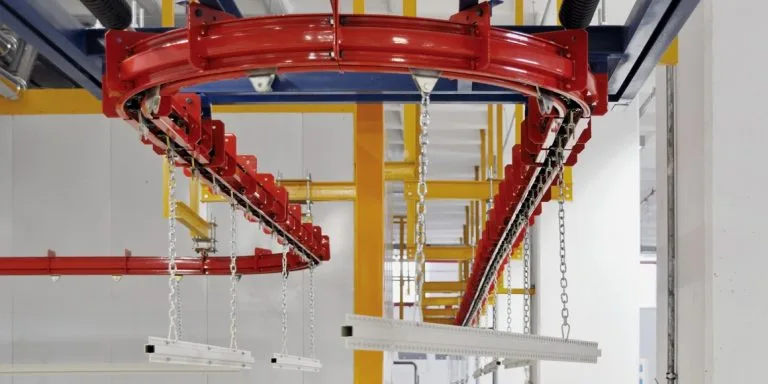
Overview
The conveyor system is the backbone of the powder coating plant, transporting parts through each stage of the process, from pre-treatment to curing.
Types and Features
4.1. Overhead Conveyors
- Purpose: Transport parts by suspending them from hooks or racks, ideal for continuous production.
- Types:
- Monorail Systems: Simple looped tracks for straightforward applications.
- Power and Free Systems: Offer more flexibility with multiple paths and stopping points.
- Features:
- Variable Speed Control: Adjust the speed to match production needs and curing times.
- Load Capacity: Designed to handle different part sizes and weights.
- Integration with Other Systems: Seamlessly integrate with pre-treatment, application, and curing systems.
4.2. Floor Conveyors
- Purpose: Transport heavier or larger parts that cannot be suspended, suitable for specific applications.
- Types:
- Belt Conveyors: Use belts to move parts horizontally or on an incline.
- Roller Conveyors: Employ rollers to facilitate the movement of parts.
- Features:
- Heavy-Duty Construction: Designed to support large or heavy parts.
- Customizable Configurations: Adapt to different plant layouts and processes.
Key Considerations
- Layout Design: Plan the conveyor layout to optimize workflow and minimize bottlenecks.
- Load and Speed Requirements: Ensure the conveyor system meets production demands for speed and capacity.
- Safety Features: Implement safety measures such as guards, emergency stops, and regular inspections.
5. Powder Coating Ovens
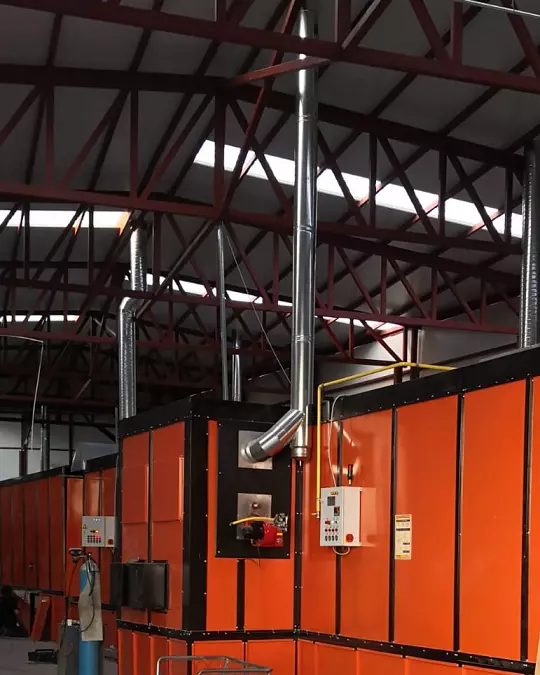
Overview
Powder coating ovens are responsible for curing the powder coating by melting and fusing it to the surface, resulting in a durable and attractive finish.
Types and Features
5.1. Batch Ovens
- Purpose: Cure parts in small batches, suitable for varied part sizes and low-volume production.
- Applications: Ideal for custom jobs, small businesses, and prototyping.
- Features:
- Adjustable Temperature Control: Precise control of curing conditions.
- Flexible Configuration: Accommodate different part sizes and shapes.
- Insulated Construction: Minimize heat loss and improve energy efficiency.
5.2. Conveyor Ovens
- Purpose: Designed for continuous production, curing parts as they move through the oven.
- Applications: Suitable for high-volume production and standardized parts.
- Features:
- Consistent Temperature Distribution: Ensure even curing across all parts.
- Variable Conveyor Speed: Match curing times with production speed.
- Energy Efficiency: Incorporate heat recovery systems and advanced insulation.
Key Considerations
- Oven Size and Capacity: Choose an oven that meets production demands without excessive energy use.
- Heating Source: Decide between electric, gas, or infrared heating based on cost and efficiency.
- Temperature Uniformity: Ensure consistent heat distribution to prevent defects in the finish.
6. Cooling and Inspection Stations
Overview
Cooling and inspection stations are crucial for ensuring the quality and consistency of the finished products. Cooling prevents defects, while inspection verifies the coating quality.
Components and Features
6.1. Cooling Zones
- Purpose: Gradually cool parts after curing to prevent warping or defects.
- Features:
- Controlled Airflow: Ensure even cooling and avoid thermal shock.
- Adjustable Cooling Rates: Customize settings for different materials and part sizes.
6.2. Inspection Areas
- Purpose: Conduct quality checks on coated parts to ensure consistency and adherence to standards.
- Features:
- Lighting and Magnification: Facilitate detailed visual inspections.
- Measurement Tools: Use instruments like thickness gauges and gloss meters for precise evaluation.
- Defect Detection Systems: Implement automated systems for detecting coating defects, such as thin spots or uneven coverage.
Key Considerations
- Quality Assurance Protocols: Establish standards and procedures for inspections to ensure consistent product quality.
- Training for Inspectors: Provide training to staff on recognizing defects and using inspection tools effectively.
- Feedback Loop: Use inspection data to inform process improvements and address recurring issues.
7. Control and Monitoring Systems

Overview
Control and monitoring systems automate and synchronize various plant operations, ensuring efficiency, consistency, and quality in the powder coating process.
Components and Features
7.1. PLC Systems (Programmable Logic Controllers)
- Purpose: Automate and control equipment functions throughout the plant.
- Features:
- Centralized Control: Manage multiple systems from a single interface.
- Real-Time Monitoring: Track performance metrics and adjust settings as needed.
- Data Logging: Record operational data for analysis and process optimization.
7.2. Data Logging and Analysis Tools
- Purpose: Collect and analyze production data to improve efficiency and quality.
- Features:
- Trend Analysis: Identify patterns and trends in production metrics.
- Performance Dashboards: Visualize key performance indicators (KPIs) for easy monitoring.
- Predictive Maintenance: Use data to anticipate equipment maintenance needs and prevent downtime.
Key Considerations
- System Integration: Ensure seamless integration with existing equipment and software.
- User Interface: Provide intuitive and user-friendly interfaces for operators.
- Cybersecurity: Implement security measures to protect sensitive data and control systems.
8. Safety and Environmental Controls
Overview
Safety and environmental controls are essential for protecting workers and ensuring compliance with regulations. These systems manage hazards and minimize environmental impact.
Components and Features
8.1. Fire Suppression Systems
- Purpose: Prevent and control powder fires or explosions in booths and ovens.
- Features:
- Automatic Detection and Suppression: Quickly identify and extinguish fires.
- Integration with Control Systems: Automatically shut down equipment in case of fire.
- Regular Testing and Maintenance: Ensure systems are operational and compliant with safety standards.
8.2. Ventilation and Filtration Systems
- Purpose: Maintain air quality by removing dust, fumes, and volatile organic compounds (VOCs).
- Features:
- High-Efficiency Particulate Air (HEPA) Filters: Capture fine particles and contaminants.
- Exhaust Fans and Ductwork: Ensure proper airflow and ventilation.
- Regular Filter Replacement: Maintain efficiency and prevent clogs.
8.3. Personal Protective Equipment (PPE)
- Purpose: Provide workers with necessary safety gear to protect against hazards.
- Components:
- Respirators and Masks: Protect against inhalation of powder particles and fumes.
- Safety Glasses and Goggles: Shield eyes from dust and chemical splashes.
- Gloves and Protective Clothing: Prevent skin contact with chemicals and powders.
Key Considerations
- Compliance with Regulations: Adhere to local and international safety and environmental standards.
- Safety Training: Conduct regular training sessions on safety protocols and emergency procedures.
- Continuous Improvement: Regularly review and update safety measures to address emerging risks and regulations.
Conclusion
Each component of a powder coating plant plays a vital role in ensuring a successful and efficient coating process. By understanding the details and functions of these components, businesses can design and operate a plant that meets their specific needs and production goals. Investing in the right equipment and systems, along with proper training and maintenance, will lead to high-quality finishes, increased productivity, and long-term success in the powder coating industry.
Installation time estimate
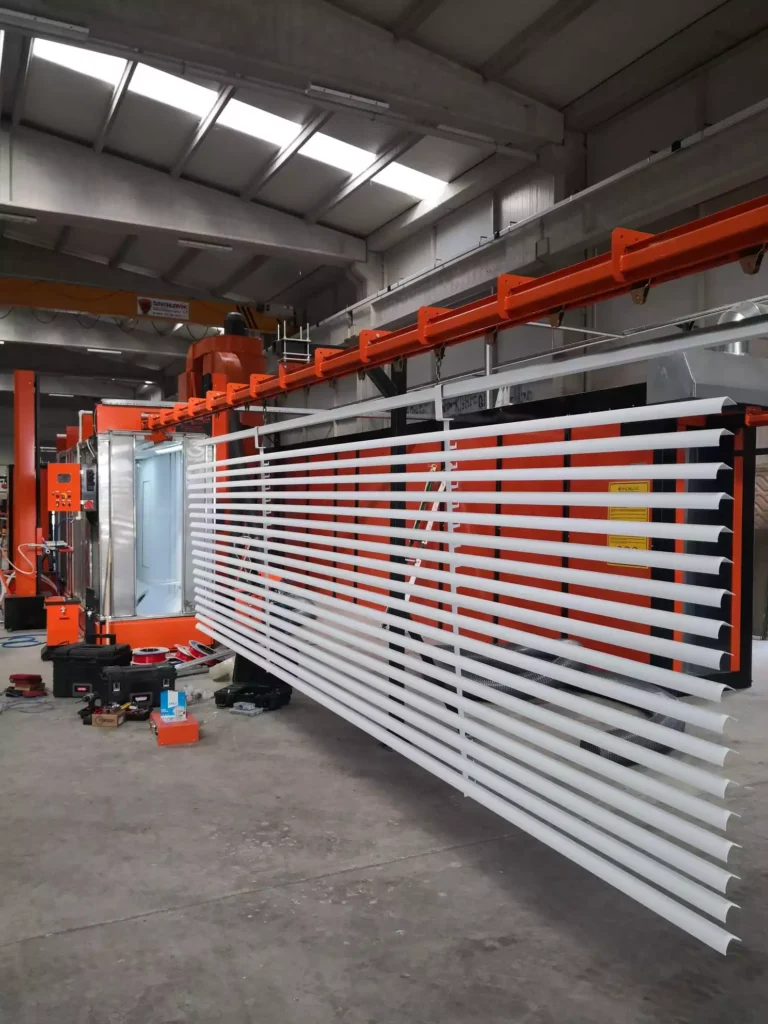
Estimating the installation time for a powder coating plant involves considering several factors such as the size of the operation, complexity of the equipment, facility preparation, and the efficiency of the installation team. Below is a detailed breakdown of the installation time estimate, including factors that can influence the timeline and strategies to ensure a smooth installation process.
Installation Time Estimate for a Powder Coating Plant
Factors Influencing Installation Time
- Scale and Complexity of the Plant
- Size and layout of the facility
- Number and type of equipment components
- Type of Equipment
- Manual vs. automated systems
- Batch vs. continuous production lines
- Site Preparation
- Existing infrastructure readiness
- Facility modifications needed
- Installation Team and Expertise
- Experience and skills of the installation crew
- Availability of necessary resources and tools
- Regulatory Compliance and Inspections
- Time required for permits and approvals
- Safety inspections and certifications
- Coordination and Scheduling
- Coordination between vendors, contractors, and stakeholders
- Availability of equipment and personnel
Estimated Installation Time by Component
Here is an approximate installation timeline for each major component of a powder coating plant. These estimates are generalized and may vary depending on specific project requirements.
1. Pre-Treatment System
- Time Estimate: 1 to 3 weeks
- Activities:
- Delivery and setup of washing, rinsing, and drying stations
- Plumbing and drainage installations
- Testing and calibration of chemical dosing systems
2. Powder Coating Booths
- Time Estimate: 1 to 2 weeks
- Activities:
- Assembly and installation of booth structures
- Integration of ventilation and powder recovery systems
- Setup of lighting and electrical connections
3. Powder Application Equipment
- Time Estimate: 1 to 2 weeks
- Activities:
- Installation of electrostatic spray guns and control units
- Calibration of application settings and nozzles
- Testing for uniform powder distribution
4. Conveyor System
- Time Estimate: 2 to 4 weeks
- Activities:
- Layout design and track installation
- Assembly of conveyor components and drives
- Testing for load capacity and speed control
5. Powder Coating Ovens
- Time Estimate: 2 to 3 weeks
- Activities:
- Installation of oven structures and insulation
- Setup of heating systems and temperature controls
- Testing for temperature uniformity and energy efficiency
6. Cooling and Inspection Stations
- Time Estimate: 1 to 2 weeks
- Activities:
- Installation of cooling systems and airflow management
- Setup of inspection stations and quality control tools
- Training staff on inspection procedures
7. Control and Monitoring Systems
- Time Estimate: 1 to 2 weeks
- Activities:
- Installation of PLC systems and control panels
- Integration with other equipment components
- Testing and validation of automation processes
8. Safety and Environmental Controls
- Time Estimate: 1 to 2 weeks
- Activities:
- Installation of fire suppression and ventilation systems
- Setup of safety barriers and emergency stops
- Safety audits and compliance checks
Total Estimated Installation Time
The total estimated installation time for a powder coating plant can range from 8 to 18 weeks, depending on the scale and complexity of the project. Here’s a breakdown by plant size:
- Small-Scale Operations: 8 to 10 weeks
- Medium-Scale Operations: 10 to 14 weeks
- Large-Scale Operations: 14 to 18 weeks
Strategies for Reducing Installation Time
- Detailed Planning and Coordination
- Develop a comprehensive project plan with clear timelines and milestones.
- Coordinate with vendors, contractors, and stakeholders to align schedules and resources.
- Pre-Fabrication and Pre-Assembly
- Opt for pre-fabricated components to reduce on-site assembly time.
- Pre-assemble equipment off-site where possible to minimize installation complexity.
- Experienced Installation Team
- Hire experienced professionals familiar with powder coating systems and processes.
- Conduct regular training and briefings to ensure the team is well-prepared.
- Efficient Site Preparation
- Ensure the facility is ready for installation before equipment arrives.
- Complete necessary infrastructure upgrades and modifications in advance.
- Streamlined Permitting and Inspections
- Obtain permits and approvals early in the project timeline.
- Schedule inspections and certifications to avoid delays.
- Contingency Planning
- Identify potential risks and develop contingency plans to address unforeseen issues.
- Allocate buffer time in the schedule for unexpected challenges.
Conclusion
The installation of a powder coating plant is a complex process that requires careful planning and coordination. By understanding the factors that influence installation time and implementing strategies to streamline the process, businesses can achieve a successful setup that meets their production goals and timelines.
Maintenance schedule tips

Creating a maintenance schedule for a powder coating plant is essential for ensuring efficient operation, minimizing downtime, and extending the lifespan of your equipment. A well-structured maintenance plan should address the needs of each component, including pre-treatment systems, powder coating booths, application equipment, conveyors, ovens, and safety controls. Here are some tips and guidelines to help you develop an effective maintenance schedule.
Tips for Creating a Maintenance Schedule for a Powder Coating Plant
1. Understand Equipment Requirements
- Read Manufacturer Guidelines: Start by reviewing the maintenance recommendations provided by the equipment manufacturers. These guidelines offer valuable insights into the specific needs and intervals for each component.
- Identify Critical Components: Prioritize maintenance for critical components that directly impact production quality and efficiency, such as spray guns, ovens, and conveyors.
2. Develop a Comprehensive Maintenance Plan
- Routine Inspections: Schedule regular inspections to identify wear and tear, leaks, or potential issues before they escalate. Inspections should cover all plant components, including electrical, mechanical, and safety systems.
- Preventive Maintenance: Implement a preventive maintenance schedule that includes tasks such as cleaning, lubrication, calibration, and parts replacement. This helps prevent unexpected breakdowns and maintains optimal performance.
- Predictive Maintenance: Utilize data analytics and monitoring tools to predict equipment failures and schedule maintenance based on condition and usage patterns.
3. Create a Detailed Maintenance Schedule
- Daily Maintenance Tasks:
- Check air pressure and filtration systems.
- Inspect spray guns and nozzles for clogs or wear.
- Clean work areas and remove powder buildup.
- Weekly Maintenance Tasks:
- Inspect conveyor systems for alignment and wear.
- Lubricate moving parts such as bearings and chains.
- Check temperature settings and calibrate sensors.
- Monthly Maintenance Tasks:
- Conduct a thorough inspection of pre-treatment systems.
- Inspect and clean ventilation and exhaust systems.
- Test and recalibrate control systems.
- Quarterly Maintenance Tasks:
- Perform a detailed inspection of the ovens for heat distribution and insulation integrity.
- Replace worn-out components such as belts and filters.
- Review and update safety protocols.
- Annual Maintenance Tasks:
- Conduct a comprehensive review of the entire plant.
- Audit compliance with safety and environmental regulations.
- Plan for equipment upgrades or replacements as needed.
4. Document Maintenance Activities
- Record Keeping: Maintain detailed records of all maintenance activities, including dates, tasks performed, and any issues identified. This documentation helps track equipment performance and identifies recurring problems.
- Use Digital Tools: Consider using computerized maintenance management systems (CMMS) to schedule, track, and analyze maintenance activities. Digital tools can provide reminders, automate scheduling, and generate reports.
5. Train and Empower Staff
- Employee Training: Train employees on the importance of maintenance and proper procedures. Ensure they understand how to identify and report issues and perform routine tasks.
- Empowerment: Encourage staff to take ownership of their equipment and be proactive in reporting potential problems.
6. Monitor Key Performance Indicators (KPIs)
- Track KPIs: Monitor KPIs such as equipment uptime, mean time between failures (MTBF), and maintenance costs to evaluate the effectiveness of your maintenance program.
- Continuous Improvement: Use KPI data to identify areas for improvement and make data-driven decisions to enhance maintenance strategies.
7. Plan for Spare Parts and Inventory
- Spare Parts Management: Maintain an inventory of critical spare parts to minimize downtime during repairs. Track usage patterns to ensure adequate stock levels.
- Vendor Relationships: Build strong relationships with equipment suppliers to ensure quick access to parts and technical support.
8. Evaluate and Adjust the Maintenance Plan
- Regular Reviews: Periodically review and update the maintenance schedule based on equipment performance, technological advancements, and changing production needs.
- Feedback Loop: Encourage feedback from maintenance staff and operators to identify pain points and improve processes.
Sample Maintenance Schedule Template
Here’s a sample template to help you structure your maintenance schedule:
| Frequency | Task | Details |
|---|---|---|
| Daily | Check air pressure | Ensure proper airflow for spray guns and equipment. |
| Inspect spray guns | Look for clogs, wear, and powder buildup. | |
| Clean work areas | Remove excess powder and debris from booths and equipment. | |
| Weekly | Inspect conveyor systems | Check alignment and wear of belts and chains. |
| Lubricate moving parts | Apply lubrication to bearings, chains, and gears. | |
| Calibrate temperature settings | Ensure accurate temperature readings in ovens. | |
| Monthly | Inspect pre-treatment systems | Check tanks, pumps, and chemical levels. |
| Clean ventilation systems | Remove dust and powder buildup in filters and ducts. | |
| Test control systems | Verify functionality and accuracy of control units. | |
| Quarterly | Inspect oven heat distribution | Check for even heat distribution and insulation integrity. |
| Replace worn components | Swap out belts, filters, and other wear-prone parts. | |
| Review safety protocols | Update safety measures and conduct training if needed. | |
| Annually | Conduct plant-wide inspection | Evaluate overall condition and performance. |
| Audit compliance with regulations | Ensure adherence to safety and environmental standards. | |
| Plan equipment upgrades | Assess the need for new equipment or technology upgrades. |
Conclusion
Implementing a well-structured maintenance schedule is vital for the smooth operation and longevity of your powder coating plant. By focusing on preventive and predictive maintenance, documenting activities, and involving your team, you can reduce downtime, improve efficiency, and maintain high-quality production standards.
Powder Coating Oven Types
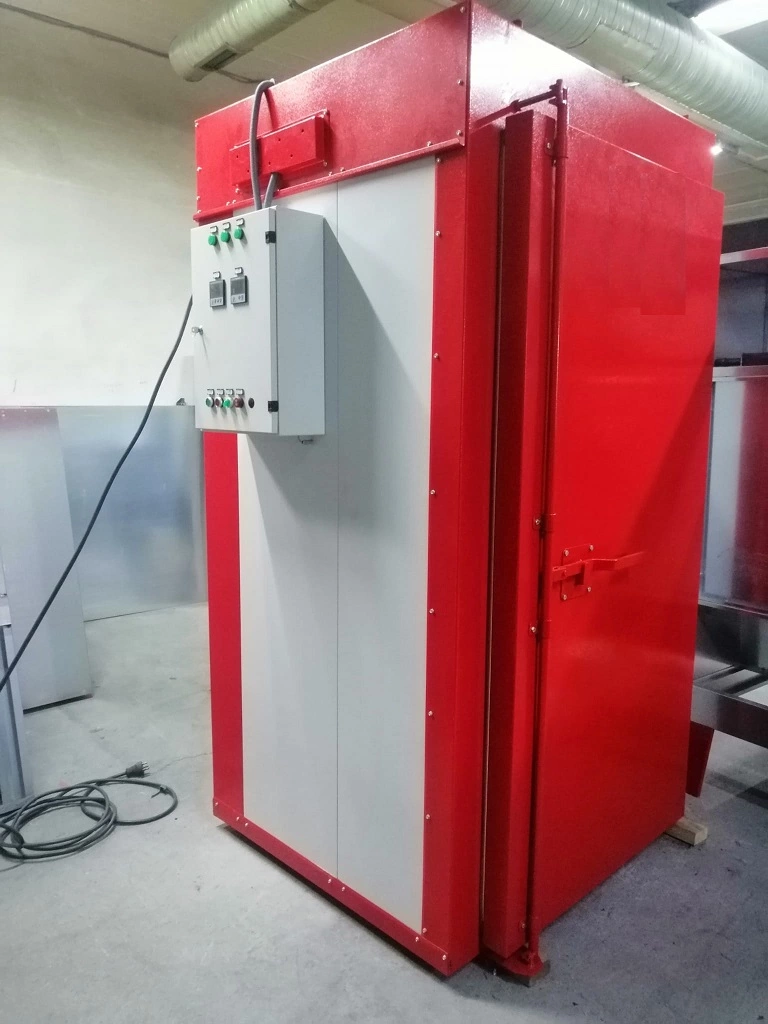
Powder coating ovens are a critical component of the powder coating process, providing the heat necessary to cure the powder and ensure a durable finish. There are several types of powder coating ovens, each designed to meet different production needs and efficiency levels. This guide will cover the various types of powder coating ovens, their features, benefits, and applications, helping you choose the right oven for your specific requirements.
Types of Powder Coating Ovens
1. Batch Ovens
Batch ovens are designed to cure powder coatings for small to medium-sized production runs. They are ideal for operations that require flexibility in coating different part sizes and types.
Features:
- Flexibility: Accommodates various part sizes and shapes.
- Energy Efficiency: Often includes insulation and heat recovery systems to reduce energy consumption.
- Manual or Semi-Automatic Operation: Suitable for low to moderate production volumes.
Benefits:
- Cost-Effective: Lower initial investment compared to continuous ovens.
- Versatile: Can handle a variety of coating tasks, including custom and complex shapes.
- Ease of Use: Simple to operate and maintain.
Applications:
- Small businesses and job shops
- Custom and prototype work
- Low to medium production volumes
Common Types of Batch Ovens:
- Walk-In Ovens: Large enough for operators to enter and load parts, suitable for oversized items.
- Cabinet Ovens: Smaller units ideal for small parts or lower-volume production.
- Truck-In Ovens: Designed for loading parts on racks or carts that can be rolled into the oven.
2. Conveyor Ovens
Conveyor ovens are designed for high-volume production and continuous processing. They automate the curing process, improving efficiency and consistency.
Features:
- Continuous Operation: Ideal for high production rates and large-scale operations.
- Automated Conveyor Systems: Transport parts through the oven for consistent curing.
- Variable Speed Control: Allows adjustment of conveyor speed to match curing requirements.
Benefits:
- High Throughput: Capable of processing large quantities of parts quickly.
- Consistent Quality: Ensures uniform curing across all parts.
- Reduced Labor Costs: Automation reduces the need for manual intervention.
Applications:
- Automotive and aerospace industries
- High-volume manufacturing plants
- Standardized parts production
Common Types of Conveyor Ovens:
- Monorail Ovens: Parts are hung from an overhead conveyor and pass through the oven in a linear path.
- Chain-On-Edge Ovens: Parts are attached to fixtures on a conveyor chain, suitable for heavier items.
- Flat-Belt Ovens: Use a flat conveyor belt to transport parts, ideal for lightweight or flat components.
3. Infrared Ovens
Infrared ovens use infrared radiation to cure powder coatings, offering a fast and energy-efficient alternative to conventional ovens. They are often used in combination with other oven types to optimize curing.
Features:
- Fast Heating: Infrared radiation provides rapid heat-up and curing times.
- Energy Efficiency: Direct heating reduces energy consumption compared to convection ovens.
- Compact Size: Smaller footprint compared to traditional ovens.
Benefits:
- Quick Curing: Significantly reduces curing times, increasing throughput.
- Targeted Heating: Infrared heat can be focused on specific areas, reducing overall energy use.
- Improved Finish: Provides smooth and even curing, minimizing defects.
Applications:
- Automotive and consumer electronics
- Applications requiring quick turnaround
- Parts with complex shapes or heat-sensitive materials
Common Types of Infrared Ovens:
- Short-Wave Infrared Ovens: Provide intense heat for fast curing, suitable for thicker coatings.
- Medium-Wave Infrared Ovens: Balance between heat intensity and penetration, ideal for general applications.
- Long-Wave Infrared Ovens: Gentle heat suitable for heat-sensitive substrates.
4. Gas-Fired Ovens
Gas-fired ovens use natural gas or propane as a heat source. They are popular for large-scale operations due to their efficiency and cost-effectiveness.
Features:
- High Heat Output: Efficiently generates high temperatures for rapid curing.
- Cost-Effective: Generally lower operating costs compared to electric ovens.
- Robust Construction: Designed to handle heavy-duty industrial use.
Benefits:
- Reduced Operating Costs: Lower energy costs compared to electric ovens, especially for large volumes.
- Reliable Performance: Consistent heating for uniform curing.
- Scalability: Suitable for large-scale production and expansion.
Applications:
- Automotive and heavy equipment manufacturing
- Large industrial operations
- High-volume powder coating lines
Common Types of Gas-Fired Ovens:
- Direct-Fired Ovens: Burners directly heat the air inside the oven chamber, providing fast and efficient heating.
- Indirect-Fired Ovens: Heat exchangers separate combustion gases from the oven air, offering cleaner operation.
5. Electric Ovens
Electric ovens use electrical heating elements to generate heat for curing powder coatings. They are commonly used in smaller operations due to their ease of use and installation.
Features:
- Precise Temperature Control: Offers accurate and consistent temperature settings.
- Easy Installation: No need for gas lines or combustion venting.
- Low Maintenance: Fewer moving parts compared to gas-fired ovens.
Benefits:
- Safe and Clean: No combustion gases, reducing emissions and improving air quality.
- Consistent Performance: Stable temperature control ensures uniform curing.
- Versatile: Suitable for various applications and materials.
Applications:
- Small to medium-sized businesses
- Custom and low-volume production
- Applications with strict environmental regulations
Common Types of Electric Ovens:
- Forced-Air Convection Ovens: Use fans to circulate heated air for uniform temperature distribution.
- Static Ovens: Rely on natural convection, suitable for delicate or sensitive parts.
6. Combination Ovens
Combination ovens integrate multiple heating methods, such as infrared and convection, to provide flexibility and optimize curing processes.
Features:
- Multi-Mode Operation: Allows switching between or combining different heating methods.
- Optimized Curing: Adjusts curing methods based on part size, shape, and material.
- Flexible Configuration: Customizable to meet specific production needs.
Benefits:
- Versatility: Capable of handling a wide range of parts and coatings.
- Improved Efficiency: Combines the strengths of different heating methods for optimal results.
- Enhanced Finish Quality: Provides tailored curing conditions to minimize defects.
Applications:
- Complex parts with varying geometries
- Industries requiring rapid production changes
- Specialized coating applications
Considerations for Choosing the Right Powder Coating Oven
When selecting a powder coating oven, consider the following factors:
- Production Volume:
- Choose batch ovens for low to medium production and conveyor ovens for high-volume operations.
- Part Size and Shape:
- Consider the size, weight, and geometry of the parts to determine the appropriate oven type.
- Energy Efficiency:
- Evaluate energy consumption and costs, especially for large-scale operations.
- Temperature Requirements:
- Ensure the oven can maintain consistent temperatures for your specific powder coatings.
- Space and Layout:
- Consider the available space and how the oven will fit into your production line layout.
- Budget and Cost:
- Balance initial investment with long-term operating costs and return on investment.
- Regulatory Compliance:
- Ensure the oven meets local safety and environmental regulations.
Conclusion
Selecting the right powder coating oven is crucial for achieving high-quality finishes and efficient production. By understanding the features, benefits, and applications of each oven type, businesses can make informed decisions that align with their production needs and goals. Investing in the right oven will enhance productivity, reduce costs, and ensure a durable, attractive finish on your coated products.
Powder coating oven maintenance tips
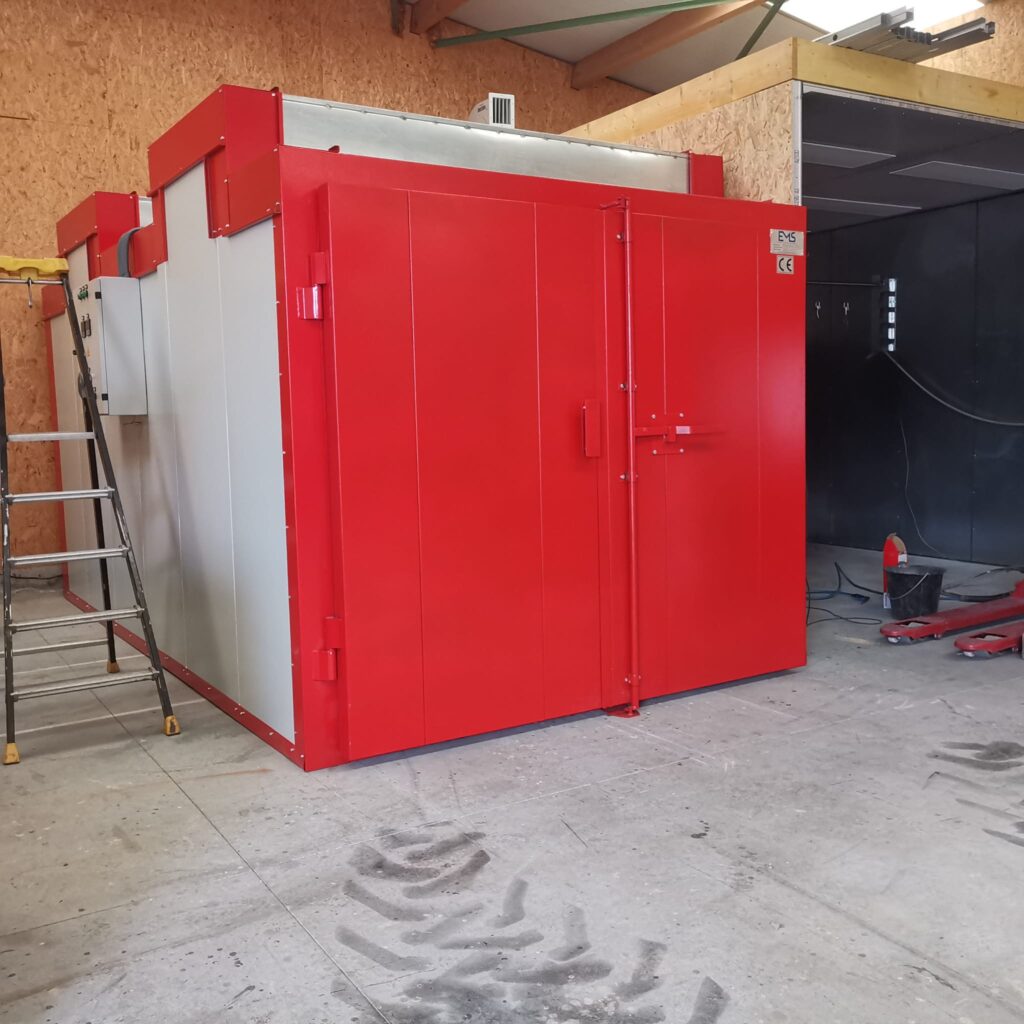
Proper maintenance of powder coating ovens is crucial to ensure efficient operation, consistent curing quality, and the longevity of the equipment. A well-maintained oven minimizes downtime, reduces energy consumption, and prevents costly repairs. Below are comprehensive tips and guidelines for maintaining powder coating ovens effectively.
Powder Coating Oven Maintenance Tips
1. Regular Cleaning
Keeping the oven clean is essential to prevent powder buildup, which can affect performance and finish quality.
Cleaning Tips:
- Daily Cleaning:
- Inspect and Clean Interior Surfaces: Remove any powder buildup on oven walls, floors, and ceilings.
- Clean Heating Elements: Check and clean heating elements to ensure efficient heat transfer.
- Vacuum or Sweep the Floor: Remove any loose powder or debris from the oven floor.
- Weekly Cleaning:
- Clean Air Ducts and Vents: Ensure proper airflow and ventilation by cleaning ducts and vents regularly.
- Wipe Down Doors and Seals: Clean door seals and check for any damage that could affect insulation.
- Monthly Cleaning:
- Deep Clean Oven Interior: Use a non-abrasive cleaner to deep clean the oven interior and remove any stubborn residue.
- Inspect and Clean Exhaust Systems: Check and clean exhaust fans and filters to prevent blockages.
2. Routine Inspections
Regular inspections help identify potential issues before they become major problems, ensuring the oven operates at peak efficiency.
Inspection Tips:
- Daily Inspections:
- Check Temperature Settings: Verify that the oven reaches and maintains the correct curing temperature.
- Monitor Airflow: Ensure that fans and blowers are functioning correctly for even heat distribution.
- Inspect Doors and Seals: Check for gaps or damage that could lead to heat loss.
- Weekly Inspections:
- Inspect Electrical Components: Check wiring, connections, and control panels for signs of wear or damage.
- Check for Unusual Noises: Listen for any unusual noises that might indicate mechanical issues.
- Monthly Inspections:
- Inspect Insulation: Check oven insulation for any damage or wear that could reduce energy efficiency.
- Examine Conveyor Systems: For conveyor ovens, inspect belts, chains, and rollers for wear and alignment.
3. Calibration and Testing
Regular calibration and testing ensure that the oven operates at the correct temperature and settings, maintaining coating quality.
Calibration Tips:
- Temperature Calibration:
- Use Thermocouples: Place thermocouples at various points in the oven to verify temperature uniformity.
- Adjust Temperature Controllers: Calibrate controllers to maintain consistent curing temperatures across the oven.
- Testing Performance:
- Conduct Cure Tests: Perform test runs with sample parts to ensure that coatings are cured properly.
- Check Heating Elements: Test heating elements for consistent output and replace any that are faulty.
4. Preventive Maintenance
Implementing a preventive maintenance schedule helps prevent unexpected breakdowns and extends the life of the oven.
Preventive Maintenance Tips:
- Lubrication:
- Lubricate Moving Parts: Apply lubrication to bearings, chains, and other moving parts to reduce friction and wear.
- Component Replacement:
- Replace Worn Parts: Regularly check and replace parts like belts, seals, and filters that show signs of wear.
- Fan and Blower Maintenance:
- Inspect and Clean Fans: Check fans for balance and clean them to prevent vibration and noise.
- Replace Worn Bearings: Replace any bearings that are noisy or show signs of wear.
5. Safety and Compliance
Ensuring safety and regulatory compliance is critical for protecting workers and meeting industry standards.
Safety Tips:
- Fire Safety:
- Check Fire Suppression Systems: Ensure that fire suppression systems are operational and regularly serviced.
- Install Smoke Detectors: Regularly test smoke detectors and alarms to ensure they are functional.
- Electrical Safety:
- Inspect Wiring and Connections: Regularly check electrical wiring and connections for signs of wear or damage.
- Conduct Safety Audits: Perform regular safety audits to ensure compliance with safety regulations.
6. Documentation and Record Keeping
Keeping detailed records of maintenance activities helps track oven performance and identify trends or recurring issues.
Documentation Tips:
- Maintain a Maintenance Log: Record all maintenance activities, including inspections, cleaning, and repairs.
- Track Performance Metrics: Monitor metrics such as energy consumption, downtime, and repair frequency.
7. Staff Training and Awareness
Proper training ensures that staff are equipped to perform maintenance tasks safely and effectively.
Training Tips:
- Provide Comprehensive Training: Train staff on oven operation, maintenance procedures, and safety protocols.
- Encourage Proactive Maintenance: Empower staff to identify and report potential issues promptly.
Sample Maintenance Schedule for Powder Coating Ovens
Below is a sample maintenance schedule to help you organize and plan oven maintenance tasks:
| Frequency | Task | Details |
|---|---|---|
| Daily | Clean interior surfaces | Remove powder buildup from oven walls, floors, and ceilings. |
| Check temperature settings | Verify that the oven reaches the correct curing temperature. | |
| Inspect doors and seals | Look for gaps or damage that could lead to heat loss. | |
| Weekly | Clean air ducts and vents | Ensure proper airflow and ventilation. |
| Inspect electrical components | Check wiring, connections, and control panels for wear. | |
| Lubricate moving parts | Apply lubrication to bearings, chains, and other components. | |
| Monthly | Deep clean oven interior | Use non-abrasive cleaner to remove stubborn residue. |
| Calibrate temperature controllers | Verify and adjust temperature settings for consistency. | |
| Inspect insulation and conveyor systems | Check insulation integrity and conveyor alignment. | |
| Quarterly | Test heating elements and fans | Ensure consistent output and replace faulty components. |
| Review safety protocols and systems | Update safety measures and test fire suppression systems. | |
| Annually | Conduct comprehensive performance review | Evaluate overall condition and plan for upgrades. |
| Audit compliance with regulations | Ensure adherence to safety and environmental standards. |
Conclusion
Regular maintenance of powder coating ovens is essential for achieving high-quality finishes, maintaining production efficiency, and ensuring equipment longevity. By implementing a structured maintenance plan, conducting regular inspections, and training staff, businesses can minimize downtime, reduce costs, and maintain a safe working environment.
